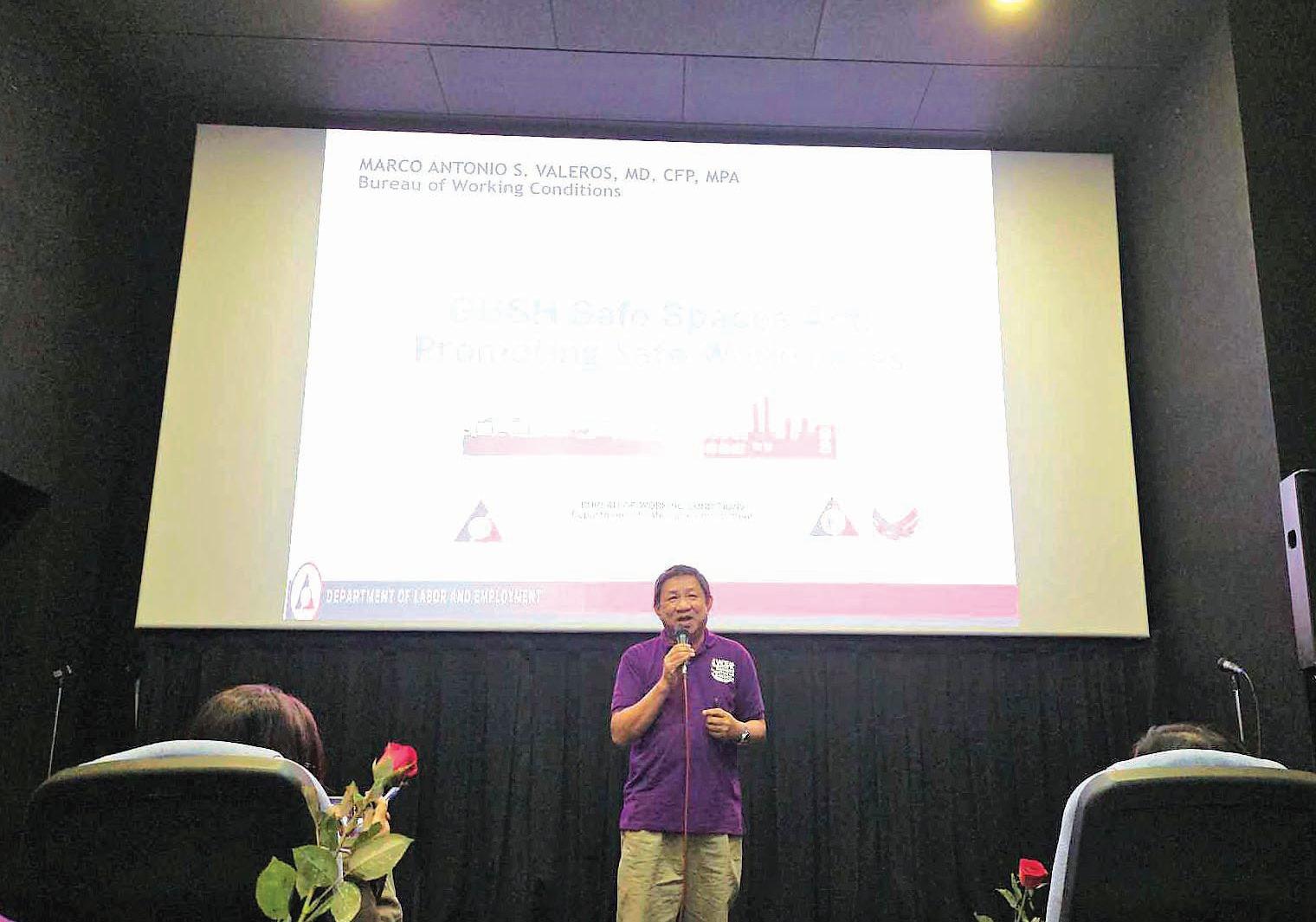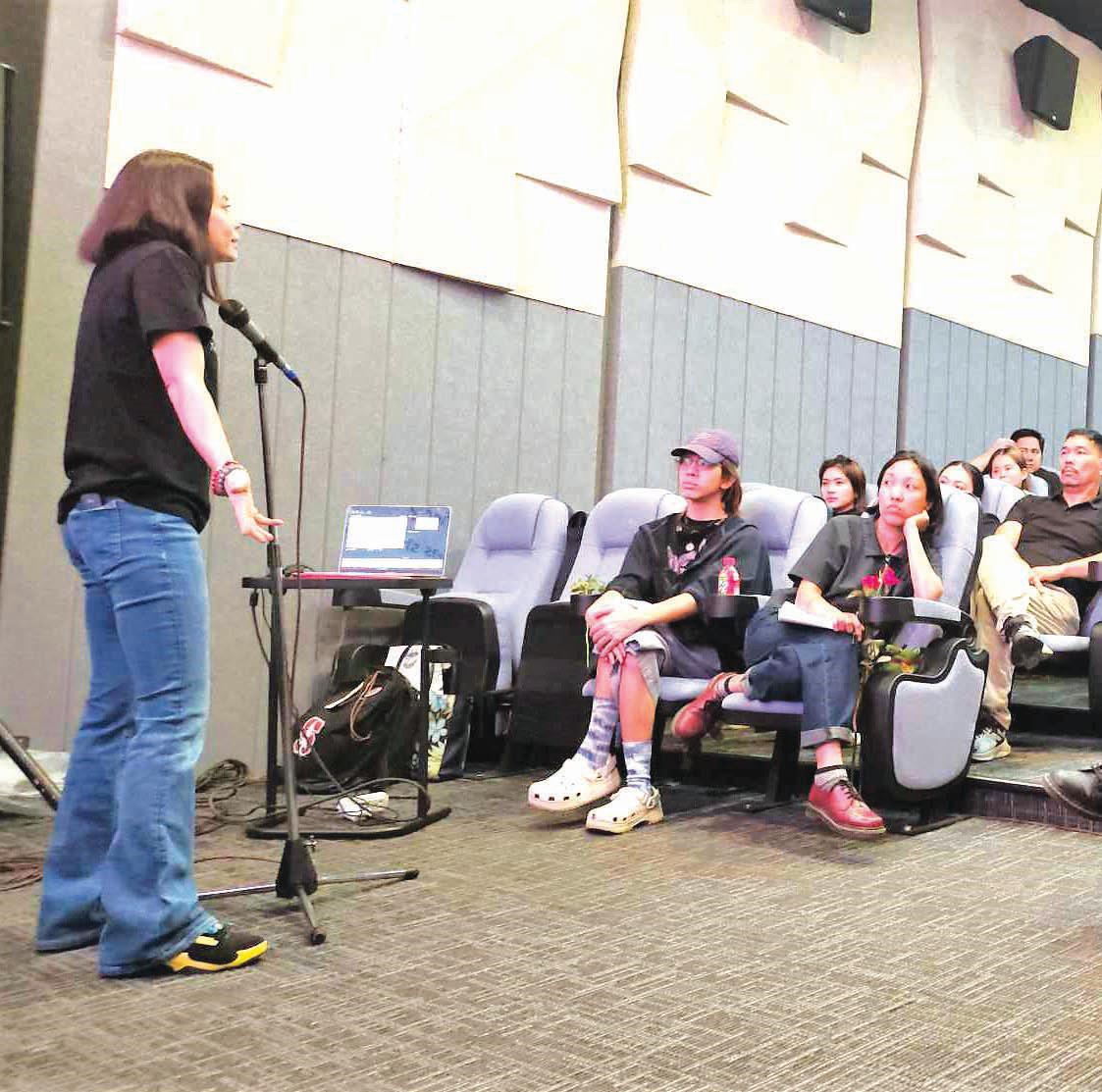




RFilipino workers (OFWs) vowed to do starting with the March 28 birthday of the now-octogenarian former president.
The “zero remittance” week until April 4, as the campaign is billed, is in protest of the arrest and transfer to the Netherlands of Rodrigo Roa Duterte to face charges of crimes against humanity in the International Criminal Court (ICC).
Can weaponizing the OFW dollars to pressure the government for Duterte actually work?
Among the first to react when an OFW from Croatia floated the idea of “zero remittance week” was presidential legal counsel Juan Ponce Enrile, thus indirectly fanning apprehension that the campaign could indeed hurt the economy.
In a post on social media, En-
rile asked aloud if the OFWs have reckoned with the possibility that the government they are threatening could hit back with sanctions, particularly targeting their tax privileges, such as their travel tax, and documentary stamp tax.
“Congress granted these privileges to them by laws enacted by it. I earnestly suggest to our OFWs to study carefully that advice to them before they get burned by it,” Enrile said.
No sanctions
MALACAÑANG, however, said the government will not impose sanctions against OFWs who refuse to send remittances to compel authorities to bring home former President Duterte.
“It is the OFWs’ choice whether they send their remittance or not. We will not hinder them in






whatever they wish,” Palace Press Officer Claire Castro said in a press briefing on Wednesday.
“As I said earlier, we have not taken any legal action because we know OFWs have their own analysis of the events,” she added.
The Presidential Communication Office (PCO) undersecretary said she is confident most OFWs will not join such a campaign since it will be detrimental to their families.
She cited the case of OFWs who refused to join a proposed zero remittance campaign in Croatia from March 28 to April 4. “As I said, most of the comments say that they will not participate in such calls because they don’t want their own families to



Continued from A1
suffer and [to] suffer from political issues,” Castro said.
However, she said people in the campaign may face charges for inciting to sedition since they are seeking to destroy the country’s economy.
Fairness, sensitivity–Kiko
COMEBACKING senator Kiko
Pangilinan also weighed in on the possibility of sanctions for zeroremitters.
“Recent discussions on the possibility of suspending the tax privileges of Overseas Filipino Workers (OFWs) who have expressed dissent have raised concerns, and I believe it is important to approach this issue with fairness and sensitivity,” said Pangilinan, a lawyer.
“OFWs are the backbone of our economy. Their hard work and sacrifices, often made at the cost of being away from their loved ones, contribute significantly to keeping the Philippine economy afloat. To threaten them with the removal of their hardearned privileges simply for exercising their right to free expression is wrong and deeply unjust.”
Pangilinan, who is seeking a Senate seat in the May elections, added: “As a democracy, we value free expression, and open dialogue has always been a cornerstone of good governance. Rather than discouraging discussions, we should welcome the perspectives of our OFWs, as they provide valuable insights into the realities faced by millions of Filipinos abroad. Their voices should be heard, not silenced.
“We must remember that freedom of speech is a fundamental right guaranteed by our Constitution. Silencing dissent through legislative threats sets a dangerous precedent. What if, in the future, the country were under a different leadership that weaponizes such threats against OFWs? It is a slippery slope that could erode the very rights and freedoms our democracy stands for.”
Instead of vilifying OFWs for voicing their concerns, the government should be listening to them. Their experiences and perspectives offer valuable insights into the realities faced by millions of Filipinos abroad. It is through dialogue and understanding—not threats—that we can build a better future for our people.
Zero tears for Duterte OFW group Migrante International, for its part, criticized overseas supporters of Duterte advocating a “zero remittance week,” for misusing a legitimate form of protest by Filipino migrants for OFW rights and welfare.
“We have zero tears for the mass murderer Rodrigo Duterte, who was rightfully remitted to The Hague,” said Josie Pingkihan, Deputy Secretary General of Migrante International.
Migrante International and the International Migrants Alliance previously led Zero Remittance Day campaigns in 2008 and 2015, calling on overseas Filipinos to collectively oppose anti-OFW policies under the administrations of Gloria Macapagal-Arroyo and Benigno Simeon Aquino. Among these were:
• Implementation of OWWA
Omnibus Policies that allowed OFW recruitment agencies to charge OFWs with higher fees;
• Use of OWWA funds for Arroyo’s electioneering;
• Tax hikes on balikbayan boxes, tanim-bala, and bukas-balikbayan box scandals;
• Neglect in providing assistance to OFW victims of exploitation and abuse.
Migrante denounced calls to twist the historic Zero Remittance call for the personal benefit of former president Duterte, who has “a litany of crimes” against migrants and the Filipino people.
Migrante called on overseas Filipinos to use the Zero Remittance call and other powerful forms of protest for the right reasons of advancing the rights of migrants and calling for genuine change in the Philippine homeland.
The economic argument AT the end of the day, it is “doing the math” that would determine whether attempting to weaponize OFWs in Duterte’s behalf could really work to pressure the government. In the view of noted economist Solita Collas-Monsod, it would not, for the simple reason that only a fraction of the OFWs globally would be inclined to join it, considering it would also hurt their own families, who must pay bills, tuition, and feed themselves.
She estimated one-fifth at most of OFWs inclined to support it, which spells $800 million at most for a week. The Bangko Sentral ng Pilipinas (BSP), with $106 billion in reserves, would surely
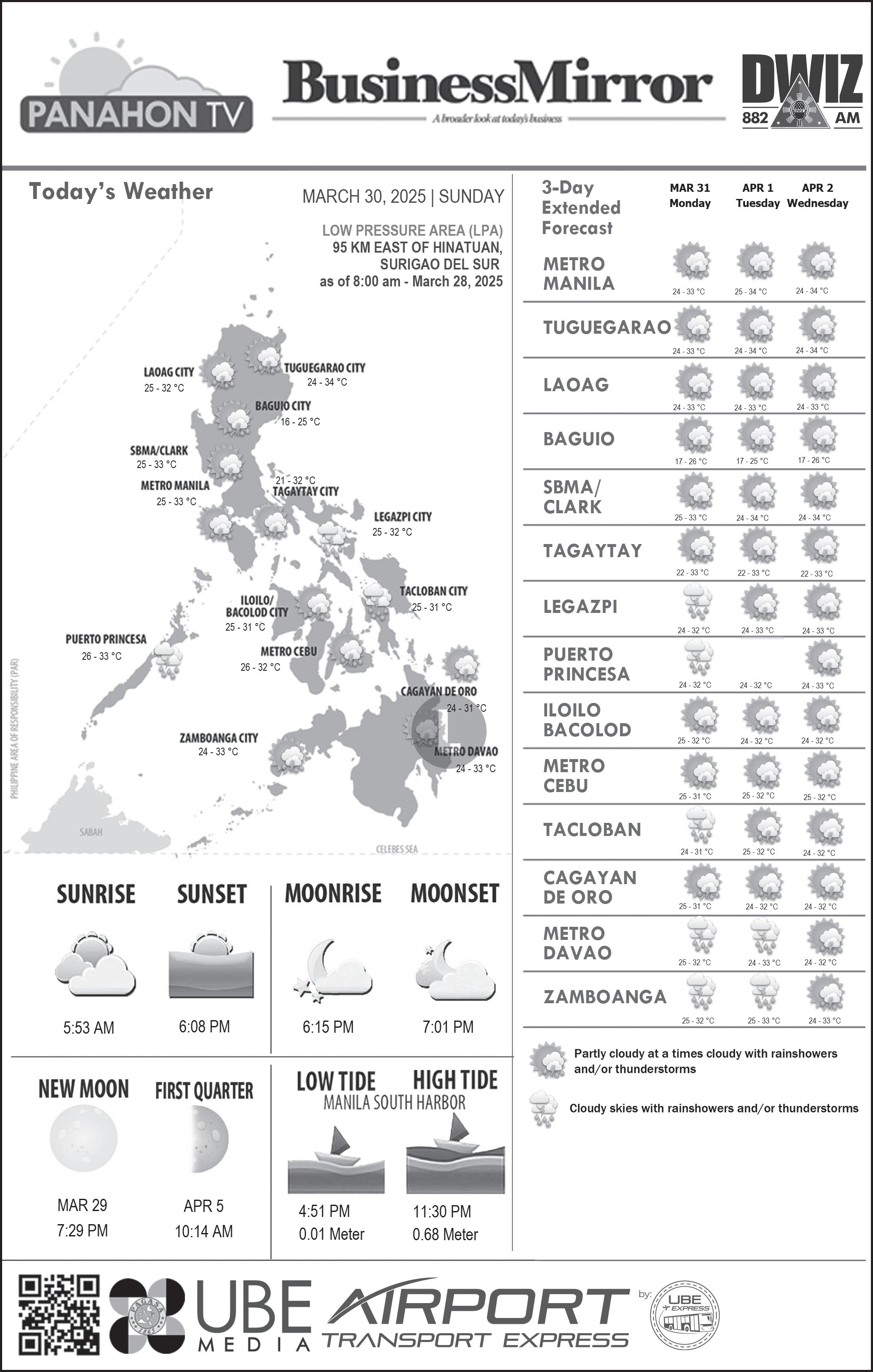
not lose time taking any intervention—if at all, according to Monsod, a former socioeconomic planning secretary and director general of the National Economic and Development Authority (Neda).
Way forward IN Monsod’s view, government should take extra effort to better explain to OFWs and their families the political situation, in order to end the deep polarization and rally Filipinos to what needs to be done to allow the country to navigate uncertain waters in an uncertain year.
An expert on migration issues, UST’s Professor Jeremaiah Opiniano, thinks the focus should be on how remittances could be impacted by unfolding developments in countries that are top sources of migrant dollars.
The Trump administration’s tariff policies on countries, for instance, may trigger a recession in the United States this year as this will create a domino effect reaching businesses and individual households.
Opiniano, the executive director of the Institute for Migration and Development Issues (IMDI), told the BusinessMirror in
an earlier interview that if a recession happens, the Philippines could see diminished remittances from United States land-based overseas Filipinos.
This could be felt in the fourth quarter of 2025 or within the first half of 2026 if Trump’s policies impact the United States economy and the recession is announced after the third quarter of 2025, Opiniano said.
Land-based and sea-based Filipinos abroad could compensate for the reduced cash remittances from the US—41.2 percent of the total.
Migrant remittances, Opiniano also noted, are historically countercyclical. “Remittances defy odds such as economic downturns and, more recently, the debilitating economic impacts of the Covid-19 pandemic.”
Opiniano cited the case of the United Kingdom, which declared an economic recession in late 2023, and Filipinos still sent a record $1.581 billion. When the UK went back to positive territory, another record $1.622 billion was remitted in 2024.
Regardless of external developments, such as cooling or heating inflation and exchange-rate fluctuations, Opiniano said the
Philippines must always be proactive in attracting remittances for development.
“If the previous efforts of banks, microfinance institutions, cooperatives, and other financial institutions to capture and increase the savings of overseas Filipinos do not work, recalibrating their financial products and services may provide new leases of hope,” Opiniano said.
Instead of merely projecting the immediate-to-medium-term future of cash remittances, financial institutions should focus on offering solutions to harness remittances as savings, investments and capital for business, he added.
The Department of Migrant Workers should also expand economic reintegration programs for OFWs still abroad and those planning to return for good. More business mentors in rural areas could help migrant entrepreneurs establish and grow sustainable businesses, according to Opiniano.
Migrant-focused NGOs should also collaborate with civil society groups experienced in areas such as financial literacy, entrepreneurship and family counseling to provide support to migrants’ welfare, Opiniano said.
With the bang of his drum, he wakes up the whole neighborhood in a Ramadan tradition
By Hassan Ammar, Amr Nabil and Manish Swarup
CThe Associated Press
AIRO—You wouldn’t think that someone who goes around banging a drum in the streets before dawn and waking up the whole neighborhood would be so beloved.
But many children and families love the musaharati, or “dawn caller,” a traditional fixture of Ramadan, the Muslim holy month when the faithful fast from dawn to sunset. It’s his job to wake people up in time to have a meal before the daily fast begins.
Across the Muslim world, the sound of a musaharati’s drum outside is as much a symbol of Ramadan as the crescent moon and the lanterns that people set up in their houses. He evokes the homey, communal feeling that the holy month brings for many, the feeling that everyone is facing the hunger of the day’s fast together—and enjoying the night’s meals together.
Often the job of musaharati is passed from father to son. So everybody in the neighborhood knows him, and he knows them.
“Wake up, Mayar! Wake up, Menna!” Essam Sayed shouted on a recent night, calling out the names of individual children as he passed outside their houses and slapped the small, brass drum that he inherited from his father.
He rode his donkey, “Saad,” through Arab Ghoneim, an impoverished neighborhood south of the Egyptian capital, Cairo. The slap of his leather strap on the drum echoed around the tiny alleyways, strung up with colored tinsel and
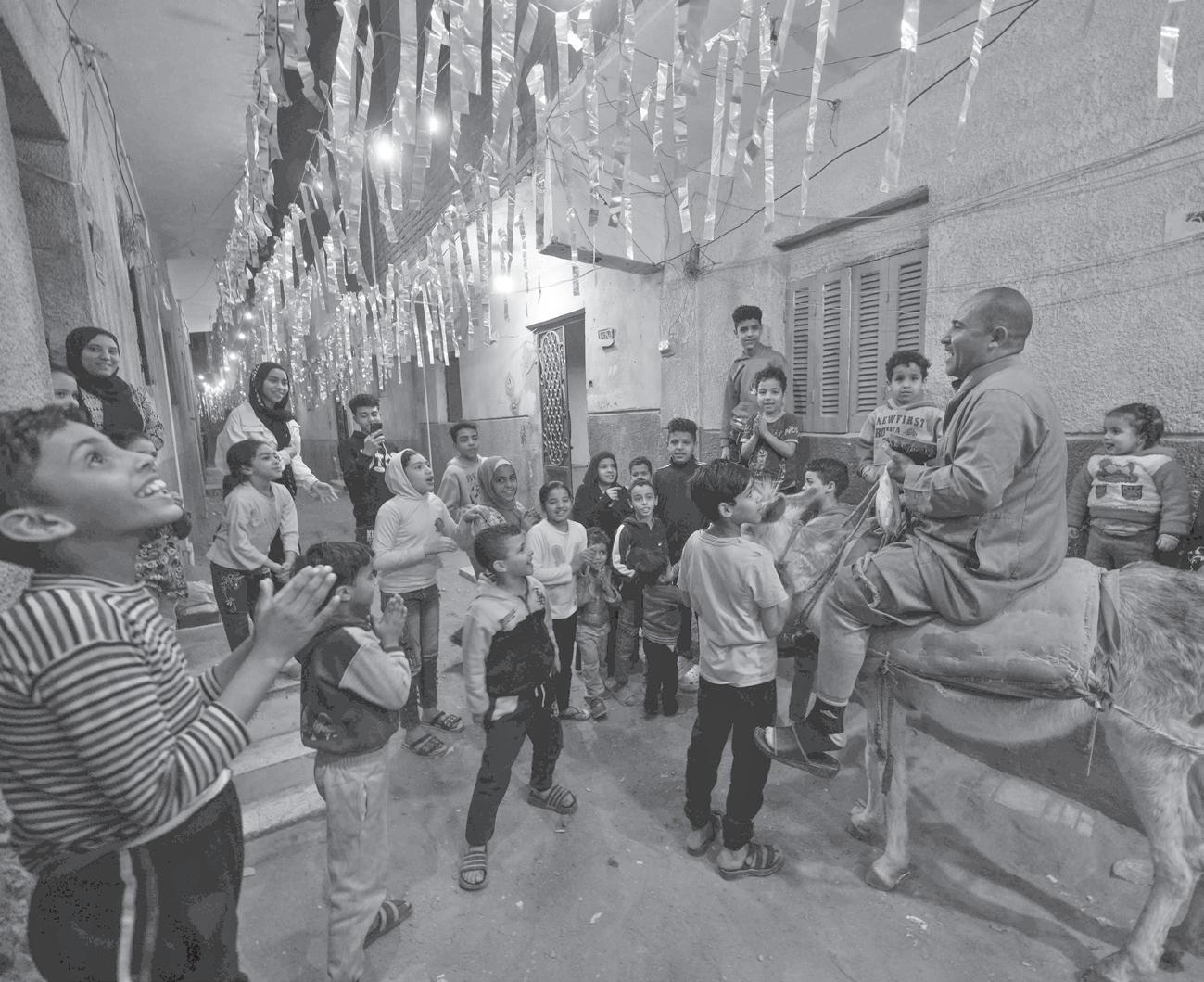
lights. Neighborhood kids gathered around him, petting and climbing on Saad.
In the Lebanese city of Sidon, Mahmoud Fanas put on a green skullcap and a green shawl over his clean white robe, an outfit that originally belonged to his father, who was also a musaharati. Then he set out on his pre-dawn circuit through the stone houses in the alleys of the old city, beating a drum.
“ Ya nayim, wahhid il-dayim,” he called out in Arabic: “Sleepyhead, worship the Eternal One!” But who needs a musaharati when you can just set the alarm on your phone to wake up for the suhour as the pre-dawn meal is known?

“Life is changing rapidly. Technology is destroying our history and causing us to lose our identity,” said Fanas, who owns a toy store. He wanted to preserve the tradition of his father, “and God willing, my children will preserve it too.”
“The most beautiful thing is when I see the children happy to see me,” he said.
The job is disappearing from many places around the Muslim world. But in many older neighborhoods trhy to preserve it. In Cairo, Sayed thought at one point about giving up, but people in the neighborhood pleaded with him to continue as a musaharati.
In India, Umar Irshad makes his way through the dimly lit alleys in the labyrinthine heart of Old Delhi, once the seat of the Muslim Mughal emperors. The 59-year-old, one of the last remaining dawn callers in the city, calls out for the devout to wake up, rings doorbells on houses and bangs on the closed shutters of shops.
He too inherited the job from his father. The tradition is fast disappearing from Delhi—and hardline Hindu nationalism in India adds extra pressure. But Irshad, a government employee, says he plans to keep it alive as long as he lives.
“I do it to please my God,” Irshad said.
WITHOUT immigra -
tion, the US population would begin to shrink in 2033, undermining the nation’s economic growth, the Congressional Budget Office said on Thursday—bringing forward its estimate for that threshold by seven years.
Annual deaths are projected to exceed the number of births in the US just eight years from now, at which point net immigration would drive population growth, according to the CBO’s long-term budget outlook report. Last year, the CBO estimated the US population would begin to shrink in 2040.
The projection showcases the risk of imposing draconian immigration policies at a time when the Trump administration has been implementing sweeping actions to curb the inflow of non-native-born people. Measures have included restricting deportation protections and sharply tightening border security. Border crossings in February were 94 percent lower than they were a year prior, according to US Customs and Border Protection data.
The CBO didn’t incorporate any of President Donald Trump’s policies in the Thursday report, as its projections were completed based on policy and economic developments before he took office.
Net immigration would “increase the size of the overall population in coming years and boost the share of people in age groups that have higher rates of labor force participation,” the CBO said in its outlook.
GDP outlook
THE latest projections by the nonpartisan arm of Congress also underscored the likelihood of weaker economic growth in coming decades.
Gross domestic product is forecast to increase at an average rate of 1.6 percent over the next 30 years, compared with the 2.5 percent average increase over the last three decades, the report said. The slowdown is due to both a weaker pace of expansion in the labor force— as the population ages and increases more modestly in coming decades—and less robust
productivity gains.
The labor force is seen expanding to 185 million in 2055 from 171 million in 2025. By the final decade of the projection period, labor-force growth is forecast at just 0.1 percent a year, a fraction of the average 0.8 percent rate seen over the past three decades.
These forecasts are subject to particular uncertainty, the CBO said. “Compounded over many years, even small changes in rates of net immigration, fertility, or mortality could greatly affect outcomes later in the projection period.”
Fiscal crisis
MEANTIME, despite all the current fervor over the application of artificial intelligence, the CBO is projecting weaker productivity gains over coming decades. That’s in part due to slower investment because of a crowding-out effect from massive public-sector borrowing.
“Increased federal borrowing is projected to reduce the resources available for private investment,” the CBO said. Declines in federal investment relative to GDP are also seen as a drag on so-called total factor productivity—a term to describe efficiency gains.
Another damper is “a slowdown in the pace at which workers’ edu cational attainment increases,” the report said.
The CBO’s projections reprised its previous warnings about the federal government heading into uncharted territory in terms of its debt burden. Debt held by the public is seen swelling to 156 percent of GDP in 2055 from 100 percent this year.
For now, the risk of a fiscal crisis “appears to be low,” but it’s not possible to reliably quantify the danger, the CBO said.
“In the agency’s assessment, no tipping point can be identified at which the debt-to-GDP ratio would become so high that it would make a crisis likely or imminent,” the report said.
“Nor is there a specific tipping point beyond which inter est costs would become so high in relation to GDP that they were unsustainable.” Bloomberg News
THE US is pushing to control all major future infrastructure and mineral investments in Ukraine, potentially gaining a veto over any role for Kyiv’s other allies and undermining its bid for European Union membership.
President Donald Trump’s administration is demanding the “right of first offer” on investments in all infrastructure and natural resources projects under a revised partnership deal with Ukraine, according to a draft of the document obtained by Bloomberg News.
If accepted, the partnership agreement would bestow enormous power on the US to control investments into Ukraine in projects including roads and railways, ports, mines, oil and gas and extraction of critical minerals. It would represent an unprecedented expansion of US economic influence in Europe’s largest country by area just at the time when it’s attempting to align with the EU.
The agreement would grant the US first claim on profits transferred into a special reconstruction investment fund that would be controlled by Washington. Crucially, the document states that the US regards the “material and financial benefits” provided to Ukraine since Russia’s full-scale invasion in February 2022 as its contribution to that fund.
In effect, this would mean the Trump administration would compel Ukraine to pay for all of the US military and economic support provided since the start of the war before Kyiv received any income from the partnership fund.
The US delivered a revised agreement to officials in Kyiv last weekend after plans for Ukrainian President Volodymyr Zelenskiy to sign an earlier accord fell apart following a tense Oval Office confrontation with Trump
last month. The White House said last week that the administration was moving beyond the previously negotiated deal covering critical minerals in Ukraine.
Discussions are continuing between the two sides and the final draft may contain revisions to the terms. Ukraine will likely respond to the US document with its own amendments this week, a person familiar with the matter told Bloomberg News.
The full agreement put forward by the US requires “detailed study” and the terms are changing constantly during negotiations, Zelenskiy told reporters in Paris on Thursday, where he’s attending a summit with European leaders. While it’s too early to say an agreement has been reached, “we support cooperation with the US, we don’t want to give a single signal that can prompt the US to stop aid to Ukraine,” he said.
The US remains committed to a quick conclusion to the agreement and to securing a lasting peace for both Ukraine and Russia, a US Treasury Department spokesperson said in response to a request for comment.
“The mineral deal offers Ukraine the opportunity to form an enduring economic relationship with the United States that is the basis for long term security and peace,” National Security Council spokesman James Hewitt said. “It will strengthen our two nations’ relationship and benefit both parties.”
Zelenskiy has sought to draw Ukraine’s allies into investing in the country as part of his socalled Victory Plan to help se -
SEOUL, South Korea—The most destructive wildfires ever to hit South Korea were almost contained, authorities announced Friday, after rain and cooler temperatures helped fire crew put out the blazes that have killed 28 people and razed vast swaths of land since last week.
In a televised briefing, Korea Forest Service chief Lim Sangseop said that all main fires at four of the hardest-hit areas in the southeast have been fully contained.
The forest service’s website shows efforts to extinguish the wildfires remain at only one place as of Friday afternoon. The government’s disaster response team earlier said that wildfires at other sites have been put out.
“As we’ve completed works to contain main fires, we’re turning into a system to deal with small fires,” Lim said. “There are still dangers of breakouts of another wildfires so we won’t loosen our vigilance and will make all-out efforts to prevent them.”
The raging inferno, fueled by windy and dry conditions, has destroyed thousands of hous -
es, factories, vehicles and other structures since last Friday, while mountains and hills were stripped to a carpet of smoldering ashes. But light rain that began Thursday night and subsequent cooler weather have helped fire-fighting efforts.
“Hazes have been diminished because of the rain last night, so that’s favorable for securing visibility. Also temperatures are now lower than the last few days, so things are very favorable to put out the wildfires,” Lim said in an earlier briefing Friday. Authorities mobilized about 9,000 people, 125 helicopters and hundreds of other vehicles Friday to battle the wildfires.
Tens of thousands have fled their homes
FIREFIGHTERS —many in their 60s, a reflection of one of the world’s fastest-aging populations—navigated forests in yellow helmets and red protective suits, spraying suppressants at flames that flickered near their feet. Helicopters dropped buckets of water over hills that glowed red in the night.
Residents hunkered down in temporary shelters in places like schools and gyms, but the fire crept dangerously close to some of them too. A video shared by one evacuee shows blazes approaching a school soccer field under a sky choked with smoke.
“I just kept crying this morning,” said 79-year-old Seo Jae Tak, an evacuee at a gym in Andong city, on Thursday. “When I went back yesterday, the entire mountain had turned to ashes. It’s just unbelievable, I can’t even put it into words. All I can do is cry.”
The wildfires have burned 47,860 hectares (118,265 acres) of land, forced more than 30,000 people to flee their homes and injured 37 others since last Friday. Officials said Friday that 8,000 residents remained at temporary shelters.
Wake-up call to overhaul wildfire responses WHILE it’s hard to link any one event to climate change, officials and experts say that it is making wildfires more likely and more severe. Scientists have already

cure it against future Russian aggression. Trump put forward his own demands for a deal to access Ukraine’s critical minerals shortly after he took office in January, as compensation for US support in the war.
Trump has moved to strike agreement with Ukraine as he also presses Zelenskiy and Russian President Vladimir Putin to reach a deal to end the war. So far, the US has pushed for Ukraine to make a series of concessions, including potentially giving up claims to territory occupied by Russia, while making practically no demands of Putin.
Ukraine secured EU candidate status in 2022 and is set to begin accession talks for full membership that could take years to complete. That’s likely to be further complicated if the US has effective control over investment decisions covering large areas of Ukraine’s economy.
Ukraine has previously said that a deal with the US must not conflict with its association agreement with the EU. It has also previously rejected the US push to include Washington’s past support for Ukraine as its contribution to the joint fund.
According to the draft document, the US International Development Finance Corporation (DFC) would control the invest -
warned the warming atmosphere around the world is driving ever more extreme weather events, including deadly wildfires, flooding, droughts, hurricanes and heat waves that are causing billions of dollars in damage every year.
“We must completely overhaul our wildfire response strategy in the face of extreme climate conditions,” said Lee Cheol-woo, governor of North Gyeongsang Province.
Lee noted that the past week has shown how wildfires can quickly overwhelm the country’s resources. He said he would request that the government establish better evacuation guidelines, adopt more powerful firefighting tools including aircraft equipped with water cannons, and adopt other approaches to improve firefighting efforts during nighttime hours.
“We don’t have the equipment for firefighting at night,” Lee said. “In the night, firefighting is done solely with manual efforts, but with the increased density of our forests compared to the past, it’s difficult to manage with just that.” AP
THE withdrawal of a timetested liquidity backstop offered by the Federal Reserve would represent the greatest risk to the dollar’s status as a reserve currency since the end of World War II, according to Deutsche Bank.
European central banking and supervisory officials have held informal discussions about the possibility that the Trump administration will push the Fed to step back from global funding markets in times of market stress, Reuters reported this week, citing unnamed sources.
There has not been any indication that the Trump administration wants the Fed to scale back the so-called swap lines that the central bank has offered during past crises. But the reported conversations in Europe come as the US is stepping away from its European allies on other fronts. Even without the Fed taking action, any fears about the reliability of the swap lines could be damaging to the dollar, George Saravelos, Deutsche Bank’s head of foreignexchange research, wrote in a note
ment fund by nominating three of five board members and holding a “golden share” that gave it special voting rights to block certain decisions. Ukraine would name the other two and be prevented from intervening in the fund’s day-today management.
The government in Kyiv would be required to put 50 percent of its earnings from all the new natural resources and infrastructure projects into the fund. The US would have the right to all of the profit plus a 4 percent annual return until its investment had been recovered, the draft stated.
Ukraine would be obliged to present all projects to the fund for review “as early as practicable,” with the DFC gaining board seats or oversight on all funded programs. Kyiv would be barred from offering rejected projects to other parties with “materially better” terms for at least one year. In addition, according to the draft, the US government would have the right to purchase Ukraine’s metals, minerals and oil and gas ahead of other parties on commercial terms, regardless of whether the fund was financing the project.
The deal, which has no time limit, also forbids Kyiv from selling critical minerals to countries that are “strategic competitors” of the US. Bloomberg News
to clients Thursday. “Were such concerns to prevail among America’s Western allies, it would likely create the most significant impetus to global dedollarisation since the creation of the post-World War global financial architecture,” Saravelos wrote. The swap lines, first launched during the 1960s, allow global institutions to borrow the greenback in exchange for their local currencies, easing demand for the dollar in times of financial stress. Revived in 2007 as the financial crisis heated up, the availability of this Fed support has long been considered an important—if infrequently-tapped—backstop during times of market turmoil. The European Central Bank, Bank of Japan, Bank of Canada, Bank of England and Swiss National Bank currently have standing swap line arrangements with the Fed. At the height of the market dislocations wrought by the pandemic in early 2020, the lines were also extended to other central banks including the Bank of Korea, the
and



By Dana Hull & Jennifer A. Dlouhy Bloomberg News
ELON Musk, the billionaire running President Donald Trump’s federal cost cutting effort, said he plans to slash $1 trillion in government spending by the end of May.
Musk, in an interview Thursday with Fox News’ Bret Baier, said he believes that his Department of Government Efficiency can find that level of cost savings within 130 days from the start of Trump’s term, which began on January 20.
That presents an ambitious goal that would require slashing more than half of the $1.8 trillion the US spent on nondefense discretionary programs in 2024.
“I think we will accomplish most of the work required to reduce the deficit by a trillion dollars within that time frame,” Musk said on Baier’s show Special Report.
Musk is a special government employee, a classification for temporary federal workers who are only supposed to work 130 days out of the year in their roles.
Musk said he wants to cut 15 percent of the government’s annual spending— which amounted to $6.75 trillion in fiscal year 2024. That’s a reduction of about $1 trillion. Musk says he is confident he can slash that amount “without affecting any of the critical government services.”
The interview came days after Trump
said that he expected to be “satisfied” with DOGE’s cuts in the coming month or two. The president has also said DOGE’s overhauls are not “necessarily a very popular thing to do,” an acknowledgment of the political risk associated with Musk’s plans for wide-ranging cuts.
Much of the federal government’s spending is on mandatory programs, such as Medicare and Social Security, where there is little leeway to make cuts. Musk has said, without citing evidence, that those programs are overrun with fraud and waste.
DOGE has deployed at least 10 staffers to the Social Security Administration to identify waste. But the data does not support claims of widespread fraud: from 2015 through 2022, Social Security estimated that it made almost $72 billion in improper payments—less than 1 percent of benefits paid, according to an inspector general report last year.
DOGE team
THE Fox interview marked the first time
BYD, China’s largest automaker, looked all set last year to build its first factory in Mexico, but then Donald Trump returned to the White House.
A project expected to create 10,000 jobs and cost roughly $600 million has stalled amid the US president’s trade war, which intensified this week as Trump announced new auto tariffs.
Now the once budding China-Mexico relationship has frosted over with both sides pulling back. Mexico, led by President Claudia Sheinbaum, has been appealing to Trump to avoid a conflict with its largest trading partner.
“At the moment, we’re not proactively looking for any Chinese investments,” said Cindy Blanco, secretary of economic development for Jalisco, the Mexican state home to Guadalajara, a potential site for the BYD factory. “We’re very aware of the implications. So we’re trying to have an aligned agenda with the US.”
Meanwhile, China has cooled on Mexico as it cozies up to the US and pushes back against Chinese imports.
In one example, China’s commerce ministry delayed approving BYD’s Mexico plant amid fears technology could leak to the US, the Financial Times recently reported. A representative of BYD declined to comment on the company’s Mexico plans.
This is a big shift from just a few years ago. During Trump’s first term, the US placed tariffs on Chinese imports, pushing Chinese firms to invest in building operations in Mexico to avoid the levies.
Next the Covid-19 pandemic upended global supply chains, making Mexico and its proximity to the US, including a new free trade agreement with America, even more appealing. Ribbon-cutting ceremonies for facilities built by Chinese firms became common.
That’s no longer the case.
“This whole geopolitical chess game has affected Chinese companies’ will -
ingness to invest in Mexico,” said Laura Acacio, a manager for Jiangyin Hongmeng Rubber Plastic Product, in a January interview.
The Chinese maker of medical supplies is now looking to expand to nearby Peru because there is a new, Shanghai-linked port and the Peruvian government is more welcoming to Chinese companies than the Mexican administration, she said. Peru has the added draw of having signed a freetrade agreement with the US that took effect in 2009.
“There is a perception by the Chinese government that the Mexican market has changed a lot,” Acacio said. Direct investment from Chinese companies in Mexico surpassed $2 billion in each of the past three years, according to data from the Latin American and Caribbean Academic Network on China. That’s roughly doubled from a decade ago.
Some of that money has gone to Hofusan Industrial Park, a large estate about 120 miles from the US border that’s partly backed by Chinese investment. As many as 40 companies with ties to China now have operations there, according to Cesar Santos, Hofusan’s president and coowner. They include furniture manufacturer Kuka Home, electronics company Hisense and auto parts makers.
But Trump has sought to stop Chinese companies from avoiding tariffs via Mexico. The president announced 25% levies on Mexico to go into effect on March 4, but then delayed them until April 2 to allow for more negotiations. These tariff threats made some firms reconsider opening plants in Hofusan, according to Santos.
Convincing Trump FOR her part, Sheinbaum, who took office in October, is seeking to convince Trump that Mexico, like the US, is a victim of unfair trade practices by China rather than part of the problem. She has adopted similar rhetoric, saying cheap Chinese imports hurt domestic industries and has cracked down on
that many of the key people working with DOGE have spoken publicly about their work. Steve Davis, a longtime Musk aide, was identified by Baier as the DOGE chief operating officer. Joe Gebbia, the billionaire who co-founded Airbnb and is on Tesla Inc.’s board of directors, also joined the interview.
So far, the accounting from Musk’s own team has shown they are still far from the $1 trillion mark. The DOGE website, which has been plagued with errors and overstatements, lists about $22 billion in contract savings. They claim about $130 billion in overall cost reductions, which aren’t itemized.
Musk’s DOGE has also spearheaded a wave of federal government layoffs that agencies have begun implementing in recent weeks.
Musk sought to downplay the job cuts, saying that “almost no one’s gotten fired.” Agencies in recent weeks have announced a spate of workforce reductions. Earlier Thursday, the Department of Health and Human Services said it would cut 10,000 jobs. Earlier this month, the Education Department said it was cutting half of its employees and the Small Business Administration is eliminating 43 percent of its workforce. The Department of Veterans Affairs said it would terminate 80,000 workers and the Treasury Department said in a court filing that large-scale cuts are planned. DOGE has faced a series of legal setbacks as judges have halted some of their cuts. Musk’s team has also been blocked from accessing some systems and databases, including at the Social Security Administration.
counterfeit goods.
China has become Mexico’s secondlargest trade partner after the US at about $140 billion a year, almost double a decade ago, according to data from Mexico’s central bank. But the relationship is lopsided, with Mexico racking up a deficit of nearly $120 billion in 2024. Meanwhile, trade with the US topped $760 billion last year, and Mexico had a surplus of more than $260 billion.
Sheinbaum has also put tariffs on clothing from countries, including China, that don’t have a trade agreement with Mexico. Her government is considering levies specifically on China and has announced a plan to use financial incentives, including tax deductions, to push companies to swap Mexican-made inputs for Chinese ones.
While analysts are skeptical that the plan will get companies to move away from Asian imports, the shift toward protectionism has had a chilling effect on some Chinese investors. Would-be clients are now “waiting a bit to make a final decision,” Santos said.
Some Chinese companies with committed investments in Mexico are planning to stick it out, in part because relocation costs are too high, according to Alan Russell, chief executive officer and co-founder of El Paso-based Tecma, which helps companies set up factories in Mexico.
By producing in Mexico, these firms also cut down on logistics costs, giving them a better shot to compete against local producers, Russell said. “Their best option is to produce here in North America.”
Enrique Dussel Peters, an economics professor at the National Autonomous University of Mexico who’s researched Mexico-China relations, said that a big drop in Chinese investment is unlikely because the business opportunity is too good. In many cases, Chinese firms provide products and materials that domestic firms don’t have the capacity to replace quickly.
“China will continue slowly growing its presence,” Dussel said. But it’s “no longer a boom time where you can come to Mexico and whatever you produce here you can sell. It has competition, and it has its risks. But it also has enormous potential.” Bloomberg News

WITH Pagasa having declared the start of the dry season in the Philippines and with the heat index rising, the challenges with energy consumption and efficient energy supply are being anticipated.
The Quantum Research for Industrial Energy Technology (QRIEnTe) project aims to address this situation through the establishment of its Quantum and Intelligent Systems Laboratory for Power Engineering (QISLaP).
“Gradually, we are transforming the industry via quantum computing. By investing in this project, we are not only tackling the present energy challenges but also establishing a foundation for a more resilient and sustainable energy future for the Philippines,” Solidum said.
TIP President Angelo Q. Lahoz also affirmed the institute’s full support to this initiative.
QISLaP will be used to conduct research on hybrid quantum computing solutions to boost the energy sector, especially in managing and optimizing the production, distribution, and consumption of energy.
Science Secretary Dr. Renato U. Solidum Jr. expressed strong optimism over the impact of a laboratory, such as QISLaP, during its inauguration on March 21.
Funded by the Deparztment of Science and Technology’s Philippine Council for Industry, Energy, and Emerging Technology Research and Development (DOSTPCIEERD), and implemented by the Technological Institute of the Philippines (TIP), the P18-million initiative is the country’s first research laboratory dedicated to using quantum computing to ensure a reliable and efficient supply of energy.
”We are grateful to the [DOST] for supporting the institution’s commitment to making research and innovation relevant. To complement DOST’s support, TIP will continue to dedicate special laboratories and collaborative workspaces for these types of applied research and special projects,” Lahoz said.
“We will also continue collaborating with our industry partners for initiatives that pool TIP talent with their corporate resources to create the best innovative solutions for their pressing needs,” he added.

for addressing key challenges, especially in the energy sector,” Apolinario said.
The approach will also assist in decision-making and testing various ideas regarding the use of different renewable energy sources at Batangas 1 Electric Cooperative Inc.
DOST-PCIEERD Executive
Director Dr. Enrico C. Paringit conveyed his enthusiasm for this breakthrough technology during the launching.
Paringit asserted that the laboratory is transformative for our nation, given the existing gaps and issues in the energy industry, as he commended the brilliant minds behind the Q-RIEnTe project.
TWO government agencies have joined forces to revitalize Philippine cotton and enhance its role in the country’s textile industry.
Through this partnership, the Department of Science and Technology-Philippine Textile Research Institute (DOST-PTRI) and the Department of Agriculture-Philippine Fiber Industry Development Authority (DAPhilFida) strive to increase local cotton production, support weaving communities, and reduce dependence on imported textile materials.
“We are here, we are open to engage. We have engineers and textile experts. We are on the same page with DA-PhilFida,” said DOST-PTRI Director Dr. Julius L. Leano Jr. Leano’s statement reinforces the institute’s readiness to collaborate, leveraging its technical expertise and research capabilities to support the resurgence of Philippine cotton for textiles.

DOST-PTRI Director Dr. Julius L. Leano Jr. (left) and DA-PhilFida Executive Director Arnold I. Atienza collaborate to leverage cotton textile innovation for the industry’s growth.
According to Engr. Gerard Francesco DG. Apolinario, PhD, a TIP professor and Q-RIEnTe project leader, the project team will develop hybrid quantum computing models to predict energy metrics (electricity demand, wind speed, solar irradiance and electricity prices) and optimize economic operations.
“The Philippines has yet to benefit from quantum computing fully, but hybrid quantum computing, which combines the strengths of classical and quantum computing, presents a promising solution
“We’re excited to witness the establishment of QISLaP, as this will serve as a research ground for esteemed experts who will be working together to create innovative solutions to make our energy systems smarter, more efficient, and more resilient,” Paringit said.
communities, which have undergone training and skills upgrading programs, have shown a strong commitment to reviving cotton weaving—a craft that demands distinct techniques compared to synthetic fibers such as polyester.
Discussions took place during the Innovation Dialogue on March 3 at the DOST-PTRI Building, where both agencies emphasized the importance of strengthening collaboration through bridging gaps in the supply chain, enhancing weaving communities’ skills, and ensuring that Philippine cotton is not only grown but also effectively utilized in high-quality textile production.

The partnership highlights the synergy between DA-PhilFIDA’s role in raw material production and DOST-PTRI’s expertise in textile innovation and capabilitybuilding.
By working closely with DAPhilFIDA and weaving communi -
DA-PhilFIDA Executive Director Arnold I. Atienza highlighted the high demand for locally produced cotton, remarking: “We have the raw materials, and with both agencies working together, we can achieve so much more.”
THE Southeast Asian Regional Center for Graduate Study and Research in Agriculture (Searca) had a leadership transition that marked the end of Dr. Glenn B. Gregorio’s tenure as the Center’s director from 2019 to 2025. Gregorio turned over the post to Dr. Mercedita A. Sombilla during the ceremony on March 24. Sombilla will begin her term as director on April 1. During Gregorio’s stewardship, Searca strengthened its role as a key driver of agricultural and rural development across Southeast Asia.
His vision steered the Center toward advancements in academic programs, digital transformation, and international partnerships with a focus on addressing critical issues, such as food security, climate resilience, and sustainable agriculture. His saw a significant expansion of Searca’s academic footprint. He championed graduate education, supporting countless master’s and PhD students through 14 joint programs with research institutions and leading universities across Asia and Europe.
Enhanced scholarship benefits and the establishment of the prestigious Outstanding Searca Scholar Award attracted and recognized top academic talents.
Recognizing the need for regional intellectual contributions, he launched 24 regional professorial grants to promote innovation in education and research in critical areas like food security and climate resilience.
Furthermore, the Leveling-Up Philippine Higher Education Institutions in Agriculture, Fisheries, and Natural Resources (Level UP HEI Afar) Project empowered 612 faculty members from 60 universities and strengthened them in terms of securing millions in funding, including grants for future-proof agriculture initiatives, publishing research, institutionalizing policies, and forging vital networks. It led to memorandum of understandings with international universities, curriculum enhancements, new extension programs, and even the addition of overseas mentors as adjunct faculty at Philippine HEIs. The Center’s global network experienced remarkable growth. It established the Southeast Asian University Consortium for Graduate Education in Agriculture and Natural Resources (UC) expanded from nine to 16 member universities, spanning
ties, DOST-PTRI aims to create an integrated and sustainable approach to cotton utilization, ensuring that both the raw material and the necessary skills are cultivated for long-term industry growth.
The DOST-PTRI has recently distributed Philippine cotton to multiple weaving communities across the country. These
Asia, Canada, and Germany, which fostered unprecedented research mobility and academic collaboration.
Initiatives like the Postgraduate MicroCredentials for Food Security and Climate Change Project, supported by Erasmus+, and the UC Young Researcher Grant provided vital support to early-career researchers.
It further played a crucial role in shaping regional policy, contributing to the development of key frameworks, such as the Asean Guidelines for Digital Technologies in Agriculture, and the Asean Regional Guidelines for Climate-Smart Agriculture, both endorsed by Asean Ministers.
Strategic roadmaps for key commodities like maize, pulses, and processed pork were also developed that directly benefitted stakeholders in the region, particularly Cambodia, Lao PDR, Myanmar, the Philippines, and Vietnam.
Digital learning and knowledge-sharing were prioritized through the Searca Online Learning and Virtual Engagement webinar

As part of the DOST-PTRI’s Philippine Cotton Weaving Movement, the institute has recently distributed cotton yarns to weavers all over the country.
A recent article on the movement highlighted its most recent recipient, National Living Treasure Magdalena Gamayo, a master weaver whose invaluable contribution to traditional textile weaving continues to inspire future generations of weavers.
series, reaching over 28,000 participants across 29 countries.
To engage the next generation in agriculture, the Youth Forces for Agricultural Innovation, and the Young Agripreneurs Building Opportunities, Nurturing Growth Bootcamp were launched.
His leadership sparked a wave of support for agricultural innovation that empowered researchers, entrepreneurs, and young agripreneurs across Southeast Asia.
The Center awarded $350,000 in Grants for Research toward Agriculture Innovation Solutions to 29 projects in eight countries that fueled the development, testing, and scaling of innovative prototypes in digital agriculture, artificial intelligence, and circular farming.
He also championed agri-enterprise incubation with the Accelerating ACT program in Cambodia, and the multi-country Sustainable Agriculture and Food Security Enhancement Accelerator to bridge market gaps through mentorship and diagnostics.
In strengthening Searca’s operational backbone, cloud-based systems, agile policies, and robust financial management were implemented and resulted in high budget utilization and positive audit results. A strong emphasis was placed on staff development, with wellness programs, leadership coaching, and career development opportunities introduced.
Gregorio’s leadership and contributions earned him international acclaim, including being one of the 2024 World’s Top 2 percent Scientists list by Stanford University, and the 2024 Outstanding Professional of the Year in Agriculture awarded by the Professional Regulation Commission.
From deluges to drought: Climate change speeds up water cycle, triggers more extreme weather
PROLONGED droughts, wildfires and water shortages. Torrential downpours that overwhelm dams and cause catastrophic flooding.
Around the globe, rising temperatures stoked by climate change are increasing the odds of both severe drought and heavier precipitation that wreak havoc on people and the environment.
Rainfall can disappear for years only to return with a vengeance, as it did in California in 2023, with record-setting rain and snowfall. That led to heavy vegetation growth that provided fuel for the devastating January wildfires in Los Angeles after drought returned.
But how can global warming cause both drier and wetter extremes? Here’s what experts say.
It’s all about the water cycle
WATER constantly moves between the Earth and its atmosphere. But that system—called the hydrological cycle—is speeding up as global temperatures get hotter, primarily due to the burning of fossil fuels like coal and gas.
A hotter atmosphere sucks up more water vapor from bodies of water and vegetation and soil.
Over land, this atmospheric demand and loss of surface moisture leads to longer and more intense droughts, even causing some arid areas to expand. Though rain falls less often, when it does, it’s often in intense and destructive deluges.
That’s because the atmosphere holds 7 percent more water vapor for every degree Celsius.
“Basically, global warming is turning the atmosphere into a bigger sponge so it can soak up more moisture ... and then when the conditions are right for rainfall, it’s like squeezing that sponge,” said
Jonathan Overpeck, a climate scientist at the University of Michigan. “You get more moisture coming out faster.”
Oceans play outsized role OCEANS absorb most of the planet’s extra heat. That causes the water to expand and ice to melt at the poles, raising sea levels. The warmer water also provides fuel for larger hurricanes and cyclones that can dump massive amounts of water in a short time.
In 2023, for example, heavy one-day rains from Mediterranean storm Daniel caused massive flooding across eastern Libya that overwhelmed two dams, sending a wall of water through the coastal city of Derna that destroyed entire neighborhoods and swept bridges, cars and people out to sea.
Climate scientists say climate change made that storm far more likely.
Snowpack is diminishing CLIMATE change also is affecting snowpack, a critical part of the hydrological cycle. Melting snow helps fill reservoirs and waterways, including for drinking and agriculture. But less snow is falling in general, and what does often is absorbed by thirsty soil.
What’s more, because winters are becoming warmer overall, the growing season is longer, meaning snowmelt also is being lost through evapotranspiration of plants. But, just like rain, climate change also can cause more intense and sometimes damaging snowstorms.
“All this stuff is related to warming, which we know with perfect confidence is almost all due to human activity,” Overpeck said. “The good news is, we know how to stop it if we want to.” Tammy
A6 Sunday, March 30, 2025

Editor: Lyn Resurreccion • www.businessmirror.com.ph
By CBCP News
ASENIOR Catholic bishop has described former President Rodrigo Duterte’s detention in The Hague as a “special grace,” urging his supporters to view it as a spiritual opportunity rather than political resistance.
Bishop Patricio Buzon of Bacolod, citing the Scripture, said Duterte, who turned 80 on March 28, is living on “borrowed time” and that his detention could serve as a moment of reckoning.
“Prison time is a powerful time, more [powerful] than any spiritual retreat,” Buzon said in his homily during Mass at Bacolod Cathedral on March 23.
“This could be the last chance for him to return to God.” Duterte has been taken to the International Criminal Court, where his critics hope he will face justice for alleged crimes
against humanity over his deadly drug war.
His supporters, however, argue that the charges are politically motivated and have called for his return to the Philippines.
The 75-year old bishop challenged Duterte loyalists to reconsider their support in light of what is best for the former president.
“True love seeks the good of the beloved. If they truly love their Tatay Digong, they will do well to leave him in peace where he is now,” Buzon said.
“If Duterte’s loyal followers profess undying love for him, they

should know that God loves him infinitely more,” he stressed.
“Duterte is, after all, a child of His. God wants him to be saved for ‘God does not take pleasure in the death of the wicked rather than that he would turn from his ways and live,’” the bishop added.
The prelate also warned that
Pope Francis’ doctor: ‘We really thought we wouldn’t make it’
ROME—The head of the medical team that treated Pope Francis during the 38 days he spent at Rome’s Gemelli Polyclinic Hospital, Dr. Sergio Alfieri, revealed that one of the most critical moments of his hospitalization was when they had to choose between continuing the therapy or letting the pope die.
“blind fanaticism” is dividing the nation, urging the public to put love of country above partisan loyalty and resist the spread of “fake news.”
“Blind fanaticism is tearing us apart as a people,” Buzon said. “It is time to put our love of country above any political loyalty lest we all perish.”
Pope: Even if we hit rock bottom, God lets us start over with Him
AS Pope Francis recovers in his residence at the Casa Santa Marta after being discharged from Rome’s Gemelli Hospital on March 23, he has called on the faithful to never lose hope, for God always grants us the possibility of starting over.
The Pope did so in the text that had been prepared for the Wednesday General Audience, which he asked the Holy See Press Office to publish.
Since his medical team discharged the Pope calling for two months of rest for a proper convalescence, the Press Office continues to distribute the catecheses prepared for the audience, as it did during his hospitalization.
In his catechesis, focusing on encounters in Jesus’ life, the pope focused on the biblical episode of the Samaritan Woman recounted in the Gospel of St. John.
At our ‘crossroads’
THE Samaritan woman meets Jesus at a well, where He asks her for water and reveals that He is the Messiah. Through their conversation,
He exposes her past and offers her “living water,” symbolizing eternal life.
Transformed by this encounter, the woman leaves her water jar, runs to her village, and brings others to Jesus.
After contemplating the encounter between Jesus and Nicodemus, who went in search of Jesus, and the Samaritan woman, the pope observed that we are reflecting on moments where Jesus shows that He is waiting “right there,” at that “crossroads” in our life.
He recognized how this could have been somewhat shocking for the Samaritan woman, who likely felt ashamed of her life.
“Perhaps she felt judged, condemned, and not understood,” said the Pope, recalling that she had had five husbands and now was with a sixth who was not her husband.
To go to Galilee from Judea, he observed, Jesus would have had to choose another road and not pass through Samaria. Yet, Pope Francis marveled, “He wants to pass through there, and stops at
that very well, right at that time!” Jesus waiting when we’ve lost all hope THIS , the pope underscored, shows how “Jesus waits for us” and “lets Himself be found precisely when we think that there is no hope left for us.”
“Jesus waits for us and lets Himself be found precisely when we think that there is no hope left for us.”
“He helps her to reread her history, which is complicated and painful,” the pope said, recalling how she discovers that the Messiah loves her.
The pope asked, “What proclamation could she have brought, if not her experience of being understood, welcomed, forgiven?”
He added that this “should make us reflect on our search for new ways to evangelize.”
Leaves behind her troubled life JUST like a person in love, the Samaritan forgets her water jar, leaving it at Jesus’ feet.
“The weight of that jar on her
head, every time she returned home,” the pope recognized, “reminded her of her condition, her troubled life. But now the jar is left at Jesus’ feet.”
At this point, he noted, “the past is no longer a burden; she is reconciled,” noting, “it is like this for us too.”
“To go and proclaim the Gospel,” the Holy Father said, “we first need to set down the burden of our history at the feet of the Lord, to consign to Him the weight of our past.”
“We first need to set down the burden of our history at the feet of the Lord, to consign to Him the weight of our past.”
“Dear brothers and dear sisters,” the Holy Father underscored, “let us not lose hope! Even if our history appears burdensome, complicated, perhaps even ruined to us, we always have the possibility of consigning it to God and setting out anew on our journey.”
Finally, Pope Francis concluded by reassuring, “God is merciful, and awaits us always!” Deborah Castellano Lubov/Vatican News
NEW Vatican data show an increase in global Catholic population by 1.15 percent to 1.406 billion between 2022 and 2023. However, there was a decrease in the number of priests equivalent to negative 0.2 percent.
The Vatican Publishing House has published the Pontifical Yearbook 2025 and the “Annuarium Statisticum Ecclesiae” 2023, which was compiled by the Central Office of Church Statistics, a department of the Secretariat of State.
The data reported in the Pontifical Yearbook offers information regarding the life of the Catholic Church worldwide for 2024. During this period, one ecclesiastical province was created; three episcopal sees were elevated to Metropolitan Sees; seven new dioceses were established; one episcopal see was elevated to an archdiocese, and an Apostolic Administration was elevated to a diocese. The Annuarium Statisticum Ecclesiae offers a snapshot of the main quantitative phenomena concerning the pastoral activity of the Catholic Church worldwide, including statistical insights for the biennium 2022–2023. The global Catholic population increased by 1.15 percent between 2022 and 2023, rising from approximately 1.39 billion to 1.406 billion, a percentage very similar to that of the previous biennium. The distribution of baptized Catholics varies in the various geographic areas, in accordance with the different demographics of each continent. Africa includes 20 percent of the Catholics of the entire planet and is characterized by a highly dynamic spread of the Catholic Church. The number of Catholics increased from 272 million in 2022 to 281 million in 2023, with a relative variation of +3.31 percent. The Democratic Republic of Congo confirms its first-place position for the

number of baptized Catholics, with almost 55 million, followed by Nigeria with 35 million; Uganda, Tanzania, and Kenya also register significant figures.
With a growth of 0.9 percent over the biennium, the Americas consolidate their position as the continents to which 47.8 percent of the world’s Catholics belong.
Of these, 27.4 percent reside in South America (where Brazil, with 182 million, represents 13 percent of the world total and continues to be the country with the highest concentration of Catholics), 6.6 percent
in North America, and the remaining 13.8 percent in Central America.
When the number of Catholics is compared to the total population, Argentina, Colombia, and Paraguay stand out, with a Catholic incidence exceeding 90 percent of the population.
The Asian continent records a growth of Catholics of 0.6 percent over the biennium, and its weight in 2023 is around 11 percent of the global Catholic population.
In 2023, 76.7 percent of Southeast Asian Catholics are concentrated in the Philippines, with 93 million, and in India, with 23 million.
Europe, while hosting 20.4 percent of the world Catholic community, confirms itself as the least dynamic area, with an increase in the number of Catholics over the biennium of just 0.2 percent.
This variation, on the other hand, in the face of an almost stagnant demographic dynamic, translates into a slight improvement in territorial presence, which reaches nearly 39.6 percent in 2023.
Italy, Poland, and Spain boast a Catholic incidence exceeding 90 percent of the resident population.
The Catholics of Oceania numbered just over 11 million in 2023, an increase of 1.9 percent compared to 2022. Vatican News
“We had to choose whether to stop and let him go, or push it and try every drug and therapy possible, running the extremely high risk of damaging other organs,” the chief doctor at Gemelli Hospital said in an interview with the Italian newspaper Il Corriere della Sera.
In the interview, Alfieri described in detail the doctors’ response to the respiratory crisis suffered by the pope on February 28.
According to the medical report published that day, Pope Francis suffered an isolated attack of bronchospasm, a severe coughing fit that suddenly worsened his clinical condition, after days of moderate optimism at the Vatican.
Although the pope never lost consciousness and cooperated with the specialists’ therapeutic maneuvers, the alarms went off, and doctors opted to place him on a noninvasive mechanical ventilation mask to help him breathe.
‘Tears in the eyes of people close to him’ “FOR the first time, I saw tears in the eyes of some people who were close to him. People who, I’ve come to understand during this period of hospitalization, truly love him, like a father. We were all aware that the situation had worsened further and there was a risk that he might not make it,” Alfieri explained.
However, despite the risk of causing irreversible kidney and bone marrow damage due to the medical treatment he underwent, they decided to act.
“We really thought we wouldn’t make it,” he said. It was a difficult decision, as Alfieri recounted, ultimately supported by the decision of the pope himself, who, through his personal health assistant, Massimiliano Strappetti, his personal nurse at the Vatican, gave a clear order: “‘Try everything, let’s not give up.’ And no one gave up.”
In the end, Pope Francis responded to the treatment. However, after his recovery, there was another moment of intense concern.
While eating, the pope suffered an episode of vomiting, and the gastric juices ended up entering his lungs.
“We were just coming out of the toughest period, and while eating, Pope Francis vomited and inhaled it. That was the second truly critical moment because, in these cases, if you don’t act quickly, there’s a risk of sudden death, in addition to complications in the lungs, which were already the most compromised organs,” Alfieri related.
‘He might not survive the night’ THE doctor explained that, despite the seriousness of the situation, Pope Francis was always fully aware, “even when his condition worsened.”
“He was aware, like us, that he might not survive the night,” the doctor stated. He added: “We saw the man who was suffering. However, from the first day he asked us to tell him the truth and wanted us to tell the truth about his condition.”
In this regard, the director of the medical-surgical department at Gemelli Polyclinic Hospital expressed the desire for transparency that prompted the Vatican to report on Pope Francis’ health.
“We communicated the medical information to the secretaries, and they added other information that the pope later approved. Nothing has ever been modified or omitted,” he noted.
The power of prayer IN the interview, Alfieri also highlighted the pope’s incredible strength, both physical and mental: “In the past, when we spoke, I would ask him how he managed to keep up this pace, and he always replied, ‘I have a method and rules.’ Beyond a very strong heart, he has incredible resources.”
In addition to the pope’s stamina, the Gemelli medical coordinator added that the prayers offered by faithful around the world in recent days also contributed to his recovery.
“There is a scientific publication that says prayer strengthens the sick. In this case, the whole world began to pray. I can say that twice the situation was lost, and then it happened like a miracle. Of course, he was a very cooperative patient. He underwent all the therapies without ever complaining,” he stated. Victoria Cardiel/Catholic News Agency via CBCP News


Editor: Lyn Resurreccion

WASHINGTON—Bird flu cases are rising rapidly in the United States and around the world. A new study traces how the disease spread over the last two decades from Asia to Europe, Africa and the Americas.
New bird species, from pelicans to peregrine falcons, are catching and carrying the disease, the study “A Geospatial Perspective Toward the Role of Wild Bird Migrations and Global Poultry Trade in the Spread of Highly Pathogenic Avian Influenza H5N1” finds.
The pattern may be a clue to why culling domestic birds has not halted the most recent outbreak.
The study shows the important role of a wider range of wild birds have as both victims and vectors of disease spread, upending previous assumptions about which birds spread the virus.
The findings point to a need to revise how we monitor and treat avian influenza in birds, wild and domestic, to best protect human health.
Today, the biggest hotspots of avian influenza are in Europe and the Americas, rather than southeast Asia as it was in the 1990s, the study finds. But it’s not only the location that’s different; the disease’s temporal pattern is different, too.
“We know H5N1 has the potential to become a human pandemic, and the risk of that happening
is higher than ever before,” said Raina MacIntyre, an epidemiologist at the University of New South Wales and study coauthor who studied influenza for more than 30 years.
“We need to really understand how it’s spreading, the role of newly infected species, and what that means in terms of risks. That gives us a better chance to mitigate those risks,” MacIntyre said.
“Using geospatial analysis techniques is key to understanding global changes in avian influenza” said Samsung Lim, a geographic information system expert at the University of New South Wales and study coauthor.
“We combined GIS with epidemiology to better characterize how and why H5N1 has escalated in such an unprecedented way,” Lim added.
The study was published in GeoHealth, which investigates the intersection of human and planetary health for a sustainable future.
Bird flu then and now MACINTYRE and her colleagues wanted to see when and where
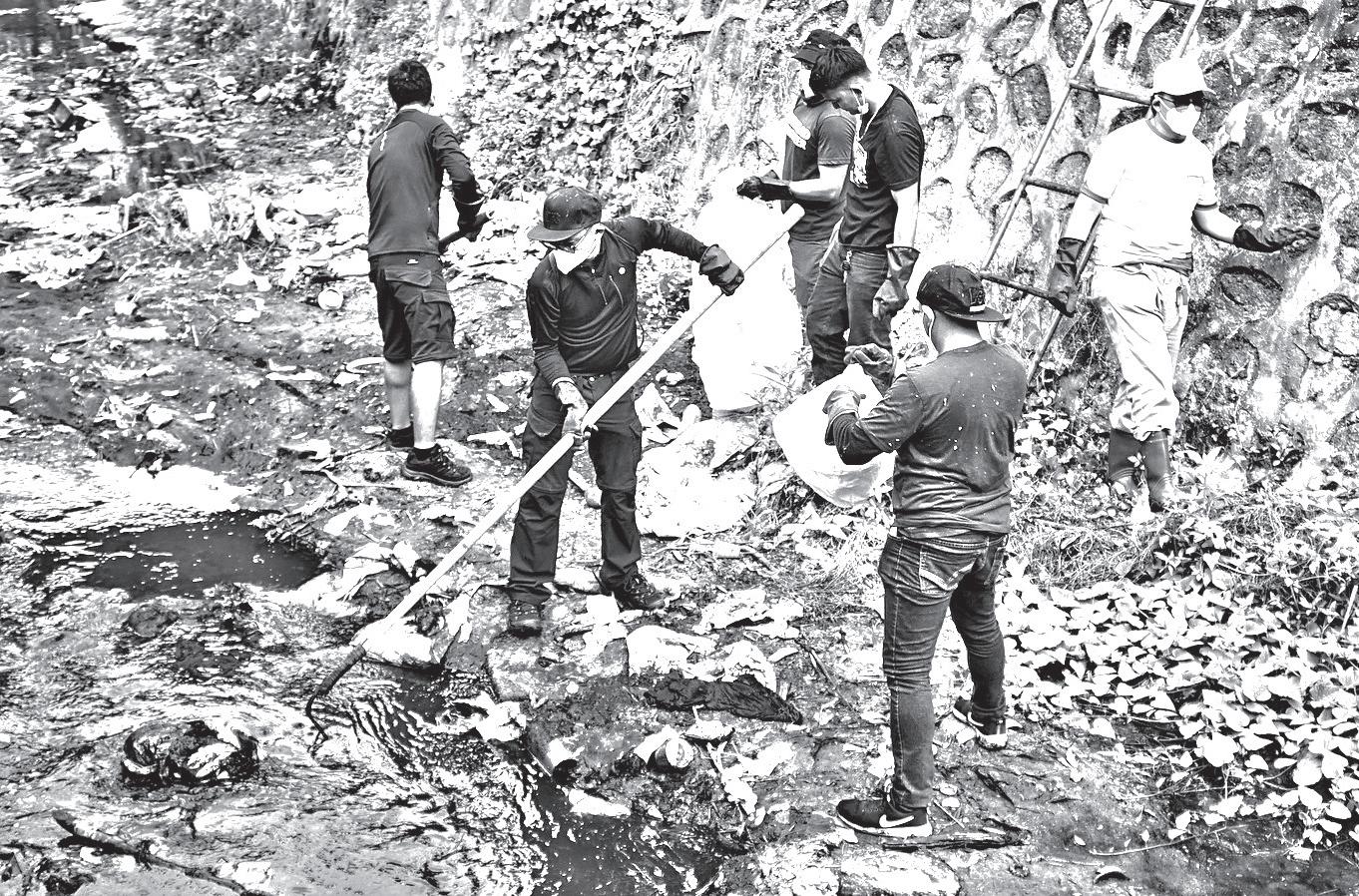
IN celebration of World Water Day 2025, Maynilad Water Services, Inc. (Maynilad) launched a series of activities— including cleanup drives, community outreach programs, and an awards ceremony—to promote water conservation and environmental protection. Maynilad employee-volunteers, together with the Muntinlupa City government, local river rangers, and a media organization, collected 172 sacks (approximately 1,366 kilograms) of garbage during a cleanup of Magdaong River. This river feeds into Laguna Lake, a vital raw water source for Maynilad’s southern customers.
The water services firm conducted another cleanup at Julian River in Imus, Cavite, reinforcing pollution prevention measures for Manila Bay.
It has also launched the WASH UP program in Muntinlupa City, featuring medical missions to improve community health and hygiene, alongside “Daloy Dunong,” an educational initiative on sanitation, hygiene, and waste management.
outbreaks happened, what species were affected, and where those species flew. The researchers used machine learning to track H5N1 outbreaks and trace the virus’ spread from 1997 to 2023.
They combined data from wild birds and poultry operations to assess when and where the two groups mixed, presenting the first comprehensive analysis of avian flu’s spread in recent decades, highlighting new species and flyways that are vectors of spread.
Birds migrate long distances using avian superhighways called flyways, which criss-cross the globe, punctuated with convenient stopover points for weary birds. There, bird species mix and mingle, including with poultry birds. It’s a perfect petri dish for the H5N1 virus to evolve in.
Ducks, geese and swans have historically been the main wild birds responsible for carrying H5N1, but they were painted as victims of infected poultry rather than a responsible party.
But H5N1’s global spread and shifting hotspots have brought that assumption under question.
The first significant outbreak of H5N1 was in Hong Kong in 1997, when 18 humans were infected following contact with chickens. Of those infected, six died.
Another outbreak hit in 2005, when there were mass die-offs of wild birds at China’s largest lake. The disease began spreading to Europe, and from there on to Africa and the Americas.
By 2010, H5N1 had infiltrated 55 countries, hinting at the role wild birds play in carrying the virus. Outbreaks then occurred
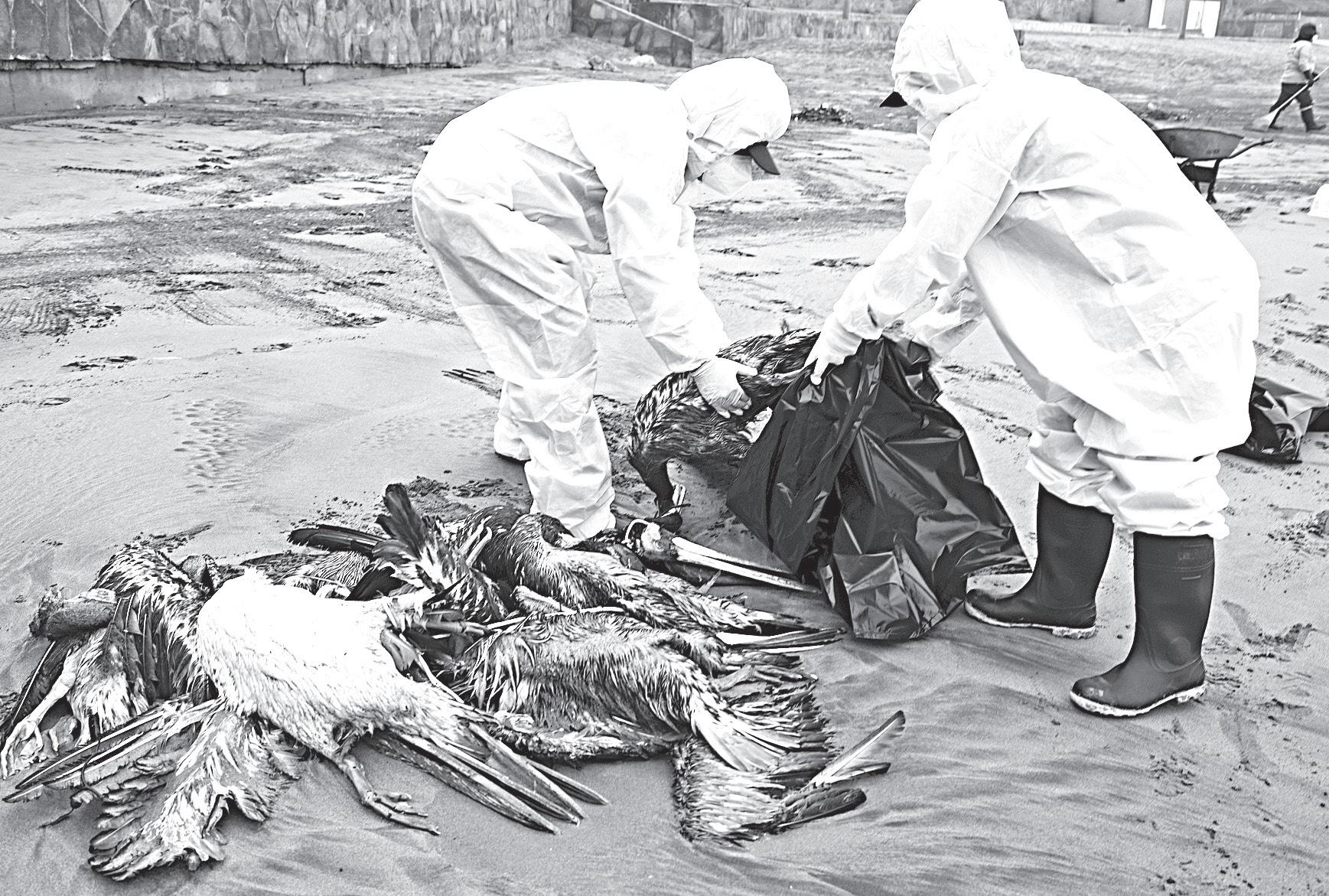
in 2014-2015 and, most recently, 2020 to today.
“Until 2020, the pattern of H5N1 was very sporadic,” MacIntyre said. “We’d see an outbreak and then it would die down.”
The outbreak that began in 2020 has failed to die down, despite the use of culling that has historically helped end avian flu outbreaks.
Wild birds: Victims and vectors FAR more bird species than ducks, geese and swans are transporting highly pathogenic H5N1 today, the study found.
Cormorants, pelicans, buzzards, vultures, hawks, and
peregrine falcons play significant roles in spreading avian flu. That makes them both victims and vectors of the disease and upends traditional approaches to monitoring H5N1 spread and predicting and responding to outbreaks.
Culling of poultry birds worked in the past to mitigate burgeoning outbreaks, but it has failed to stop the current outbreak.
“We’ve got to think beyond ducks, geese and swans,” MacIntyre said. “They’re still important, but we have to start looking closely at these other species and other routes and think about what new risks that brings.”
Monitoring wild birds at a global scale is very difficult, so managing poultry bird populations is all the more important, she said.
“We can do more about factors in our control—agriculture and farming,” she pointed out. Free-range birds, for instance, are more likely to contact wild birds, so managing them requires more vigilance.
And pigs are “an ideal genetic mixing vessel” for viruses, so keeping pigs and poultry in close proximity is dangerous, she said.
“It’s a global problem, and it requires global solutions,” MacIntyre said. American Geophysical Union
PICTURE an ocean world so deep and dark it feels like another planet—where creatures glow and life survives under crushing pressure.
This is the midwater zone, a hidden ecosystem that begins 650 feet (200 meters) below the ocean surface and sustains life across our planet.
It includes the twilight zone and the midnight zone, where strange and delicate animals thrive in the near absence of sunlight.
Whales and commercially valuable fish such as tuna rely on animals in this zone for food. But this unique ecosystem faces an unprecedented threat.
The company is also set to roll out Bigkis-Tubig, a program focused on conserving, protecting, managing and rehabilitating local water resources through community engagement and sustainable practices.
A highlight of the month-long celebration is the World Water Day Awards, where Maynilad honored individuals, institutions, and programs championing water security and environmental sustainability. The awards was in partnership with the National Water Resources Board, the Department of Environment and Natural Resources, and seven other water and environment agencies.
“Environmental protection is a responsibility we take seriously. Through these initiatives, we engage the public in safeguarding water resources and ensuring a sustainable future for all,” said Maynilad Chief Sustainability Officer Atty. Roel S. Espiritu.
Maynilad is the largest private water concessionaire of Metropolitan Waterworks and Sewerage System in the Philippines in terms of customer base.
As the demand for electric car batteries and smartphones grows, mining companies are turning their attention to the deep sea, where precious metals, such as nickel and cobalt can be found in potato-size nodules sitting on the ocean floor.
Deep-sea mining research and experiments over the past 40 years have shown how the removal of nodules can put seafloor creatures at risk by disrupting their habitats.
However, the process can also pose a danger to what lives above it, in the midwater ecosystem.
If future deep-sea mining operations release sediment plumes nto the water column, as proposed, the debris could nterfere with animals’ feeding, disrupt food webs and alter animals’ behaviors.
As an oceanographer studying marine life n an area of the Pacific rich in these nodules, believe that before countries and companies rush to mine, we need to understand the risks.
Is humanity willing to risk collapsing parts of an ecosystem we barely understand for resources that are important for our future?
Mining the Clarion-Clipperton Zone
BENEATH the Pacific Ocean southeast of Hawaii, a hidden treasure trove of polymetallic nodules can be found scattered across the seafloor.
These nodules form as metals in seawater or sediment collect around a nucleus, such as a piece of shell or shark’s tooth. They grow at an incredibly slow rate of a few millimeters per million years.
The nodules are rich in metals such as nickel, cobalt and manganese—key ingredients for batteries, smartphones, wind turbines and military hardware.
As demand for these technologies increases, mining companies are targeting this remote area, known as the Clarion-Clipperton Zone, as well as a few other zones with similar nodules around the world.
So far, only test mining has been carried out. However, plans for full-scale commercial mining are rapidly advancing.
Exploratory deep-sea mining began in the 1970s, and the nternational Seabed Authority (ISA) was established in 1994 under the United Nations Convention on the Law of the Sea to regulate it.
But it was not until 2022 that The Metals Company and Nauru Ocean Resources Inc. fully tested the first integrated nodule collection system n the Clarion-Clipperton Zone.
The companies are now planning fullscale mining operations in the region and expect to submit their application to the ISA by June 27. The ISA will convene in July 2025 to discuss critical issues such as mining regulations, guidelines and benefit-sharing mechanisms.
The proposed mining process is invasive. Collector vehicles scrape along the ocean floor as they scoop up nodules and stir up sediments.
This removes habitats used by marine organisms and threatens biodiversity, potentially causing irreversible damage to seafloor ecosystems.
Once collected, the nodules are brought up with seawater and sediments through a pipe to a ship, where they’re separated from the waste.
The leftover slurry of water, sediment and crushed nodules is then dumped back into the middle of the water column, creating plumes. While the discharge depth is still under discussion, some mining
operators propose releasing the waste at midwater depths, around 4,000 feet (1,200 meters).
However, there is a critical unknown:
The ocean is dynamic, constantly shifting with currents, and scientists don’t fully understand how these mining plumes will behave once released into the midwater zone.
These clouds of debris could disperse over large areas, potentially harming marine life and disrupting ecosystems.
Picture a volcanic eruption—not of lava, but of fine, murky sediments expanding throughout the water column, affecting everything in its path.
The midwater ecosystem at risk
AS an oceanographer studying zooplankton in the Clarion-Clipperton Zone, I am concerned about the impact of deep-sea mining on this ecologically important midwater zone.
This ecosystem is home to zooplankton—tiny animals that drift with ocean currents—and micronekton, which includes small fish, squid and crustaceans that rely on zooplankton for food.
Sediment plumes in the water column could harm these animals.
Fine sediments could clog respiratory structures in fish and feeding structures of filter feeders.
For animals that feed on suspended particles, the plumes could dilute food resources with nutritionally poor material. Additionally, by blocking light, plumes might interfere with visual cues essential for bioluminescent organisms and visual predators.
For delicate creatures such as jellyfish and siphonophores—gelatinous animals that can grow over 100 feet long— sediment accumulation can interfere with buoyancy and survival.
A recent study found that jellies exposed to sediments increased their mucous production, a common stress response that is energetically expensive, and their expression of genes related to wound repair.
Additionally, noise pollution from machinery can interfere with how species communicate and navigate.
Disturbances like these have the potential to disrupt ecosystems, extending far beyond the discharge depth. Declines in zooplankton populations can harm fish and other marine animal populations that rely on them for food. The midwater zone also plays a vital role in regulating Earth’s climate. Phytoplankton at the ocean’s surface capture atmospheric carbon, which zooplankton consume and transfer through the food chain.
When zooplankton and fish respire, excrete waste, or sink after death, they contribute to carbon export to the deep ocean, where it can be sequestered for centuries. The process naturally removes planet-warming carbon dioxide from the atmosphere.
More research is needed DESPITE growing interest in deep-sea mining, much of the deep ocean, particularly the midwater zone, remains poorly understood. A 2023 study in the Clarion-Clipperton Zone found that 88 percent to 92 percentof species in the region are new to science.
Current mining regulations focus primarily on the seafloor, overlooking broader ecosystem impacts. The International Seabed Authority is preparing to make key decisions on future seabed mining in July 2025, including rules and guidelines relating to mining waste, discharge depths and environmental protection.
These decisions could set the framework for large-scale commercial mining in ecologically important areas such as the Clarion-Clipperton Zone. Yet the consequences for marine life are not clear.
Without comprehensive studies on the impact of seafloor mining techniques, the world risks making irreversible choices that could harm these fragile ecosystems. Alexus Cazares-Nuesser, University of Hawaii/The Conversation (CC) via AP




Adam Silver:
Basketball is the No. 2 sport in Europe. It’s widely popular. Hundreds of millions of fans. Roughly 15 percent of the players in the NBA right now are from Europe. Five out of the last six of our MVPs have been European.
By Tim Reynolds The Associated Press
NEW YORK—The National Basketball Association (NBA) may soon be significantly expanding its presence in European basketball, in the form of partnering with FIBA on a new league that the sides have been talking about for many years.
Specifics are few, with the initial targe —for now—being that it would be a 16-team league.
But the announcement made recently by NBA Commissioner Adam Silver and FIBA secretary general Andreas Zagklis is a major step forward after a long process of the sides going back and forth with ideas about what might work.
“We feel now is the time to move to that next stage,” Silver said, noting that NBA owners offered “enthusiastic support” for such a move.
It’s a notion that has made sense for some time, particularly with the growth of the game in Europe and development of stars hailing from that part of the world. About one in every six current NBA players hail from Europe, including Denver’s Nikola Jokic (Serbia) and Milwaukee’s Giannis Antetokounmpo (Greece)—who have combined for five of the last six MVP awards—along with the Los Angeles Lakers’ Luka Doncic (Serbia) and San Antonio’s Victor Wembanyama (France).
“Basketball is the No. 2 sport in Europe. It’s widely popular. Hundreds of millions of fans. Roughly 15 percent of the players in the NBA right now are from Europe. Five out of the last six of our MVPs have been European,” Silver said. “But there’s a huge gap, I think, between the amount of interest in the sport and the development in terms of how we operate a league here in North America.”
rules, such as a 40-minute game instead of the NBA’s 48-minute model, Silver said. But much of the other details— who, when, where—will be determined in the months ahead.
“FIBA has been running competitions for almost seven decades, since the 1957-58 season, and certainly we have seen great product,” Zagklis said. “We have seen great players. But at the same time, we have come to the conclusion that the popularity of the sport and the success that we’ve had with the national team competitions is not matched by fan interest and a commercial impact commensurate to that success.”
The NBA and FIBA, the sport’s global governing body, were in discussions for some time about adding either an annual competition in Europe or having an NBAoperated league there. It was a topic at a Board of Governors meeting this past September, one where Zagklis took part.
BOSTON—Ashley Wagner and Ben Agosto know what it’s like to step off the ice at the figure skating world championships and feel as though they’ve conquered the sport. And what it feels like when the notoriously fickle sport bites back. So when the International Skating Union (ISU) put in motion its ambitious “Vision 2030” plan, which is designed to grow and expand the sport through improved fan engagement, it made sense that they would call Wagner, a three-time US champion and former world silver medalist, and Agosto, who won an Olympic silver medal with ice dance partner Tanith Belbin. If anyone was going to interview athletes at this week’s world championships at such an emotionally raw moment, the minute after their programs have concluded, it ought to be someone who has been through it themselves.
“I would have loved this when I was an athlete, to have the post-skate interviews right in the kiss-and-cry, when the emotions are so fresh,” Wagner said. “That’s something being brought into this production. We’ve
never seen anything like it.” Look closely, and you might notice a lot of things never seen before at this week’s worlds: cutting-edge LED dasher boards surrounding the rink, grand entrances for the athletes, and more energetic music—like the rocked-out version of “I’m Shipping Up to Boston” by the Celtic punk band Dropkick Murphys that keeps blaring inside TD Garden.
The idea is simple: The ISU wants to make figure skating feel cool again. Or at least, cool to more people.
Those who love the intricate, nuanced sport—the spins and jumps, the brilliant landings and bitter falls—tend to follow it year-round. But there are just as many fans that tune in once every four years, during the Winter Olympics, when like a shooting star the athletes spring onto the public consciousness and then fizzle as soon as it ends.
“Skaters are the reason why this sport exits,” explained ISU president Jae Youl Kim, who granted The Associated Press a behind-the-scenes tour of the world championship setup Thursday, shortly before the start of the men’s short program.
and clearly things were trending this way since at least last summer if not even longer.
“Coming out of the most successful World Cup and Olympics ever, we also believe it is the right time to take the next step for club basketball,” Zagklis said.
In January, speaking at the NBA Paris Games—when the league took advantage of the trip to France to meet with European stakeholders on the topic of the future of basketball on that continent—
Silver said he believes the NBA remains “on track” in the process of expanding its footprint in Europe. That was also when he said the league’s governors would be briefed further at the March meeting.
“The response we’ve gotten from the marketplace is very positive,” Silver said.
Zagklis said FIBA’s leadership also unanimously agrees that it’s the right time to partner with the NBA on a new league.
“Our role as a federation is to unite the basketball ecosystem,” Zagklis said.
The new league—which would likely carry some sort of NBA branding, given how recognizable the league and its logo are—would be part of the current European club system, and teams would also play in their respective national leagues.
One of the ideas being floated, if it is a 16-team final product, is to have perhaps as many as four spots available to be reallocated through relegation, something popular in European leagues but nonexistent in major US sports.

“We are so proud of our athletes and we want to make sure we shine a brighter, stronger spotlight on our skaters.”
That is why those brilliant LED dasher boards are showcasing each

athlete’s social media tag, and why each is being introduced individually for the first time, something track and field and other Olympic sports have embraced over the years. AP
The NBA and FIBA would also provide money and resources to the continued development of the game in Europe, with more team academies and adding to their existing programs there designed to work with players, coaches and
“Given the opportunity to design a league from scratch, one of the things we’re looking at is what are the best elements we can take of both systems,” Silver said.
November 1, it was officially announced—the Philippines had made it to the OQT.”
“At the time, it was uncharted territory, but with the support of FIBA and SBP, we made it happen. The rest is history,” he said. “That’s why we’re back to where it all began. Together with SBP, SGA and Smart, Philippine 3x3 is in good hands.”
A total of 16 teams showed up in the friendly tournament that featured squads from SBP, Smart, SGA and media representatives. SBP Gilas Boys, a team composed of utility members from Ginebra and TNT emerged victorious and won P100,000 along with four sacks of rice from Jillian Rice Mill and P20,000 worth of shoes from Premium Outlets of former Azkal Misagh Bahadoran. Each player from the champion team also received one sack of rice from Jillian Rice Mills. SGA, bannered by the firm’s president Jacob Lao, wound up second and ia generous gesture, Lao donated the P30,000 prize money to the event staff to amplify the spirit of camaraderie.
SBP Elite copped third place and received P20,000—the squad led by SBP brass Ryan Gregorio, Gilas Women’s 3x3 team manager Larry Fonacier and Bacon Austria. PLDT/Smart First Vice PresidentHead of Sports Jude Turcuato underscored the importance of sports in uniting communities and fostering national pride.
“In a study conducted by Smart, we found that sports have a unique power to bring people together, regardless of background,” Turcuato said. “This tournament is proof of that. Through collaboration and a shared goal, we are hopeful that we can propel the Philippines back into the Olympic basketball stage.”



Role models. Peer pressure. Rewards. WHAT REALLY GETS PEOPLE TO ACT MORE SUSTAINABLY?
MARCH 30, 2025 | soundstrip.businessmirror@gmail.com




Publisher :
T. Anthony C. Cabangon
Editor-In-Chief :
Lourdes M. Fernandez
Aldwin M. Tolosa
Concept :
Y2Z Editor :
SoundStrip Editor :
Group Creative Director : Graphic Designers :
Jt Nisay
Edwin P. Sallan
Eduardo A. Davad
Niggel Figueroa
Anabelle O. Flores
Contributing Writers :
Tony M. Maghirang
Rick Olivares
Jill Tan Radovan
Reine Juvierre S. Alberto
John Eiron R. Francisco
Pocholo Concepcion
Francine Y. Medina
Justine Xyrah Garcia
Bea Rollo
Trixzy Leigh Bonotan
Bless Aubrey Ogerio
Photographers :
Bernard P. Testa Nonie Reyes
Y2Z & SOUNDSTRIP are published and distributed free every Sunday by the Philippine Business Daily Mirror Publishing Inc. as a project of the
The Philippine Business Mirror Publishing, Inc., with offices on the 3rd Floor of Dominga Building III 2113 Chino Roces Avenue corner
Dela Rosa Street, Makati City, Philippines. Tel. Nos. (Editorial) 817-9467; 813-0725.
Fax line: 813-7025
Advertising Sales: 893-2019; 817-1351,817-2807. Circulation: 893-1662; 814-0134 to 36. www.businessmirror.com.ph

By Reine Juvierre S. Alberto
THE sound of old-school music, audiophiles digging through crates and the warm community of music lovers—these were on full display as the One Stop Record Fair: Vinyl in Motion found a new home at Ayala Malls Trinoma.
The quarterly vinyl record fair has become a haven for collectors and casual listeners and a staple in Manila’s music scene. Previous fairs were held in various malls across the metro, but this time’s twoday event in Trinoma last March 15 to 16, became even better.
Nestled in the heart of Quezon City, Trinoma offers a bustling and accessible location, to reach a broader audience, which drew in patrons, curious mall-goers and the younger generation.
The staple all-day old-school music spun by Manila’s veteran DJs, the intimate and nostalgic atmosphere and a great selection of vinyl records were maintained but more upgrades set it apart from prior fairs.
Music madness
THE fair was filled with 20 vinyl vendors offering rare, first presses, limited editions and new ones.
Audiophiles dug through wooden crates of vinyl filled with rock, pop, jazz, soundtracks, country, classical and OPM music.
Among the records sold at the event were Olivia Rodrigo’s Sour: Limited Edition and Laufey’s Bewitched: The Goddess Edition with a custom board game by Rudy’s Records.
Kapitan Plaka also sold HONNE’s signed vinyl record OUCH and Dead Ends’ box set while Mamsyrecords with Clair Marlo’s original press and Mariya Takeuchi’s Variety.
Music, Movies and More PH offered Dennis Lambert’s Bags and Things, as well as Jamiroquai’s Canned Heat.
One Stop Record Fair newcomer Vicor Music had a nostalgic OPM lineup with TVJ Tough Hits Vol 1 to 3, Pabs Dadivas’ Haribol, Regine Velasquez’s R3.0, and Ugat: The Best of Pinoy Folk Rock.
Perfect Day Records also sold rare finds like Come To The Sunshine: Soft Pop Nuggets From The WEA Vaults and The Cure’s Mixed Up Picture Disc.
Manila Vinyl catered to rock and electronic fans with Appetite for Destruction by Guns N’ Roses, Third Wave – Third Stage, and Daft Punk’s Random Access Memories.
DEKADA Collectibles, meanwhile, sold Filipino classics such as VST 1, Boy Friends 1, Hotdog Unang Kagat (original press), E. Munji’s Pinoy Jazz and Francis M’s Yo.

APART from vinyl records, there were also CDs, cassette tapes, band shirts and other vintage items, such as coins and bills, and collectibles sold at the event.
Local artists Jecman, Marius Black and JC Sebastian displayed and sold their artworks at the event.
Marius Black’s artworks touched on Filipino street scenes, childhood imaginings and cats while JC Sebastian used a mixed media art style focused on music.
Jecman’s augmented reality stickers were a hit among younger attendees, which came to life when scanned with a smartphone.
Trinoma also added its own spin to the event, offering a free freshly made mocktail from TGI Fridays or a beautifully curated flower bouquet from Smitten. Customers just need to present a minimum single receipt worth P500 from any Trinoma merchant.
THE vinyl resurgence in the Philippines has been in motion, and a growing number of young listeners, particularly Generation Z, have embraced the tangible nature of vinyl records amidst the rise of music streaming.
Local actors and vinyl enthusiasts Marlo Mortel, Batang Quiapo’s Jorel Ramirez and Robert Seña, known for his role in Miss Saigon, were also spotted at the fair.
“Everybody is so happy selling and buying vinyl records. The vibe this time just hits different,” Sari Osorio, organizer of the One Stop Record Fair told SoundStrip
“I am thankful that Ayala Malls Trinoma supported One Stop Record Fair by being our venue partner. I think we found our new home,” she added.
As the fair wrapped up its first Trinoma run, it is brewing up the second installment for this year happening in June.
For now, Manila’s vinyl collectors can rest assured that One Stop Record Fair has found a new groove, spinning better than ever.
By Ica Hontiveros-Cheng
YOUNG Blood Neet enters the room, he is tall and lanky for his twenty three years of age. Dressed in a denim jacket, jeans, and a black jewel encrusted cap, perched precariously on his head, but never falling, as if by magic, granted by the gods of Pinoy Hip-Hop.
He settles on the black couch, the green logo of Spotify illuminating behind him. ‘YB’ as he prefers to be called, is part of the prestigious Spotify 2025 Radar Program. The Spotify RADAR Program is a global initiative dedicated to putting the spotlight on emerging artists by giving them a platform to expand their reach and support their careers.
Some of today’s hitmakers have been party of Spotify RADAR Program, artists such as SB19, Ben&Ben, have graduated
from the Spotify RADAR program, and now, it’s time for a new class to shine and Young Blood Neet has made the cut, with over 71 million streams under his belt, he is indeed a force to be reckoned with in the local hip-hop scene.


The Young and the Restless CURIOUS, I had to ask him how he came about his stage name. Why ‘Young Blood Neet’?
YB answered: “From all the groups that I’m a part of, I’m always the youngest… the youngest in charge. So I decided to manifest that; to always be the youngest artist and that’s where I got the name ‘Young Blood Neet’.”
I couldn’t help but remark that he does have a baby face. He nods, unfazed by the compliment, a big silver ring glistening on his pinky finger.
We get back to business: “You are part of the Spotify Radar Program for 2025, What do you feel that you are part of this prestigious program?” I ask him. “I’m

excited because this is a new direction for the ‘YB Neet’ brand.” I make a mental note that he refers to himself as a brand. Something which will surely help him along the way, in his career. “I’m excited and at the same time I’m just ready to go! Even before I found out that I was part of this (Spotify Radar 2025) we were already locked in the studio for three months, we were just focused everyday, that was our routine, making music.” YB says as he slaps the back of his hand on his palm, in emphasis of the focus and the work that they have been doing.
“It was all worth it, all the work that we have been doing, it’s all for this (Spotify Radar) that’s why we are even more on fire.
Following a legacy
WITH big names associated with the Spotify Radar program I just had to ask YB how he felt following artists who have been part of Spotify’s Radar Program; as they have already achieved so much and are now at the top of their game. How does it feel that you are now in their place before?
“I feel that it was really the right timing that this all happened. I knew that this was going to happen, I just didn’t know when. I was just being prepared for when it was going to happen. I’m in game mode.” YB says.
Looking back
AS the conversation deepend YB looked back to his humble beginnings, he started writing songs during the
pandemic, and says that even if the pandemic didn’t happen, he would still end up where he is today. He recalled a story of going to the market with his mom as a child, and he saw this hip hop CD which caught his eye that was only worth P30.00.
He asked his mom to buy the CD. Excited, he went home and played it, even as a child he was moved by the beat, by the words, he got up on the couch, thinking that it was a stage and started moving along to the song. It was at that moment that he knew that he belonged in this world of hip-hop and music.
With the many doors that will undoubtedly open for YB as part of the Spotify Radar Class of 2025 I had to ask him what was his message to the new listeners who will encounter his name, his brand, and his music.
“Once you listen to me. There’s no coming back.” YB says with a smile and a twinkle in his eye.
And he surely has a lot to smile about, a seat in the coveted Spotify Radar class will put him on the map and will allow for more curious listeners to discover his music. If he was well on his way to the top before, the program has solidified that for sure.
YB will be joined by other local artists to make up the Spotify Radar 2025 class, each one with their game faces on and burning with so much potential. You will see their faces, you will know their names, you will hear their music. They’re all ready for their close up and to drive the future of Filipino music.
By Leanne Italie
The Associated Press
YORK—
Lauren Click founded a nonprofit a few years ago offering free composting education to schools around the United States. Today, 112 schools participate, yet she can’t get her boyfriend to properly separate his trash at home in Scottsdale, Arizona.
“Adults have more set behaviors than young kids. I try to model a behavior and hopefully he does it,” said Click, executive director of her Let’s Go Compost organization. “But it’s also like, I’m not his parent. I’m not going to berate him every day or ruin my relationship over this. I just fish a bunch of stuff out of the trash.”
Her efforts, which she calls 50-50 effective with her partner, point to an important question in the field of environmental psychology: What’s the best approach when looking to influence colleagues, friends and family to live more sustainably? What’s the worst?
Researchers say Click is on the right track. Modeling can work, though as with other approaches, it depends on who the sender is, how the message is framed and who it’s intended for.
Here’s a look at some of the issues and strategies involved in making people more aware of their role in climate change, which is caused by the burning of fuels like gasoline, coal and gas, and encouraging them to cut waste and protect the natural world.
MAGNUS Bergquist is an associate professor of psychology at the University of Go -

thenburg in Sweden. His research focuses on how to persuade people to adopt more eco-friendly behavior. In a recent study reviewing studies in his area, Bergquist homed in on the influence of others.
“What we found was the most effective strategy for changing behavior is social norms, pointing to what other people are doing or people’s perception of other people’s approval or disapproval,” he said.
“But interestingly,” Bergquist added, “when we ask people about the effectiveness of different interventions, people tend to say that social norms are among the least effective ones.”
The bottom line: Humans are generally social animals, which isn’t a surprise. But most people underestimate how much they’re influenced by social norms, and campaigns are often based on strategies that are less effective, he said.
Financial incentives also work, to a degree
WHILE Click is unlikely to pay off her boyfriend to do better, Bergquist said financial incentives or disincentives are the second most effective strategy (behind social norms) in getting people to take more sustainable steps in their lives.
That covers everything from bonus cash in a community or office to tax benefits, he said. But there’s a caveat.
When people change their behavior because of financial incentives or disincentives, “some studies show that it crowds out people’s moral compass,” he said. “They will
do it for the money. They won’t do it for the sake of the question as such.”
Example: A popular way to promote proenvironmental behavior is holding a contest for something like conserving energy or riding your bike to work.
“Ride your bike and a get a prize,” Bergquist explained. “What we see over and over again is that’s effective in the short term. When the prize or the contest is removed, people tend to go back.”
Education is good, but not enough by itself
NORAH Hippolyte is the business manager for St. Mary Magdalen Parish in socially progressive Berkeley, California. She supplies table goods for workers and a wide range of group gatherings, from funerals and community dinners to functions for the parish’s school.
For several years, she’s been trying to wean everyone onto compostable plates, cups, bowls and utensils.
“So, I buy the stuff. I make sure people are aware I’ve got it in the closet, that that’s where I keep everything. I say, use this stuff. Make sure you let me know when people start to run low,” she said. “But people choose not to use what’s there. They’re using their own things, and it’s all regular plastic.”
She tries to get them to rinse and recycle, or clean what’s cleanable so it can be used again.
“When I started working in Berkeley, I figured everybody had this whole recycle
thing down. Nooooo,” Hippolyte said. “Not only did I have to learn, I have to now try and teach people, OK, this bin is for this, this and this. That bin is for this. Sorting is the biggest issue.”
Hippolyte’s experience doesn’t surprise Bergquist. “I always want to mention education—trying to inform people or educate people about issues— because that tends to be ineffective alone,” he said.
Bergquist says those who have been talking themselves to death or shoveling facts into the faces of reluctant folks should add some other motivation.
For example, when Sarah Davies was trying to convince her 16-year-old son to give up single-use plastics, she switched strategies.
“He truly believed he can use plastic as much as he likes and then put it into the recycling bin,” said Davies, who heads up communications for Earthday. org, organizers of the April 22 Earth Day. “What finally made the difference was me explaining that when he’s drinking from a single-use plastic bottle, be it water or soda, he’s also drinking potentially 240,000 nano particles of plastics. That shocked him.”
Bergquist noted that a couple of experiments have indicated that people pay more attention to negative information than positive information.
“So instead of saying many people are pro-environmental, you can say people are avoiding environmentally harmful products,” he said. “It’s the avoidance.”
It’s a small but potentially valuable tweak, Bergquist said. Take straws.
“Instead of saying people are using paper straws, you might say most people are avoiding plastic straws. You don’t have to explain. People will find an explanation,” he said.
Other expert tips for persuasion include picking your battles; starting small, focusing on one habit; appealing to the person’s interest in other benefits, like saving money or being more efficient; keeping it easy; and not forcing the issue.
HOW do you get those around you to recycle, drive less, use less plastic and otherwise live more sustainably?
“Getting the people we live with to adopt more sustainable habits can be tricky, especially if they’re not already on board,” said Silvia de Denaro Vieira in San Francisco. She’s the co-founder of the
home management app Coexist, which helps families collaborate at home.
In addition to leading by example, she has these suggestions:
n Pick your battles and start small.
“Focus on pointing out one habit—like composting, reducing single-use plastics or taking public transit—and build up from there,” she said.
n Frame sustainability around the other person’s priorities. “If they don’t care about sustainability, focus on what they do care about. Many eco-friendly choices also save money, cut down on clutter or make daily life more efficient. For example, meal planning reduces food waste and saves money.”
n Make it easy. “Small shifts like keep-

ing reusable bags in the car or setting up a simple recycling system can make sustainable choices feel automatic rather than like extra work.”
n Respect the other person’s boundaries. “If someone is resistant to a particular habit, it helps to take a step back and focus on what’s working rather than forcing the issue. Sustainability is a long game.” AP
Text and photos by
Reine Juvierre S. Alberto
WHEN I found out I was going to Taiwan, all I could think about was the food
I was going to eat. Taiwan is a relatively small country but it is big on flavors. With a land area stretching only 36,193 square kilometers, food in this now self-ruled island seems boundless. Taiwanese food, much like the Philippines, builds on the cuisine of its colonizers and migrants. When the Fujianese and Hakka communities went to Taiwan in the 16th century from China, their food came along with them. There were also influences from Japan and European countries as well as modern politics.
My mind was boggled for weeks by the famous beef noodle soup, stinky tofu and boba milk tea that Taiwan is famous for. So when we landed at the Taoyuan International Airport for a familiarization trip, I knew I was in for a treat.
Plum powder addiction
Starting my first morning in Taiwan right, I visited the hotel’s buffet to see the local Taiwanese breakfast offerings. I filled my big plate with the essentials: warm scallion pancake, steamed dumplings, barbecue bun and sweet custard bun. I also grabbed a bowl of congee topped with pork floss and crispy fried bread with a cup of hot, sweet peanut milk. I sat down with Ivy Chen, our 69-year-old tour guide, who noticed my plate lacked fiber and generously offered me her starfruit. She taught me how they usually dip any fruit, even french fries, in plum powder, which I never heard before.
The texture was fine, as I initially compared it to iodized salt, and its taste struck the perfect balance of sweet and sour—enough to make your eyes pop and nod your head in approval. Since that experience, I made it my mission to find this addictive powder in a supermarket and bring it home. And I did!
Banquet dining
We were generously treated to banquet food in our hotel’s private room. Chinese dishes were constantly placed on the round table


Oand we kept spinning the turntable to try everything.
We started with appetizers, such as the salted and sun-dried mullet fish roe paired with leeks, stir-fried chicken kidney, boiled chicken in soy sauce, soft tofu with bonito flakes and braised asparagus with bamboo fungus. Signature dishes like Peking duck, king prawns with truffle and cucumber, steamed nine-hole fish, beef and broccoli in red wine sauce and steamed sea grouper black were served while chicken ginseng soup added a comforting touch.
Ivy said that the eldest person at the table must eat the fish’s head and tail, as both parts must be eaten to “finish what you started”—a belief tied to the saying “y ǒu tóu y ǒu wěi,” meaning “completeness and seeing things through.”
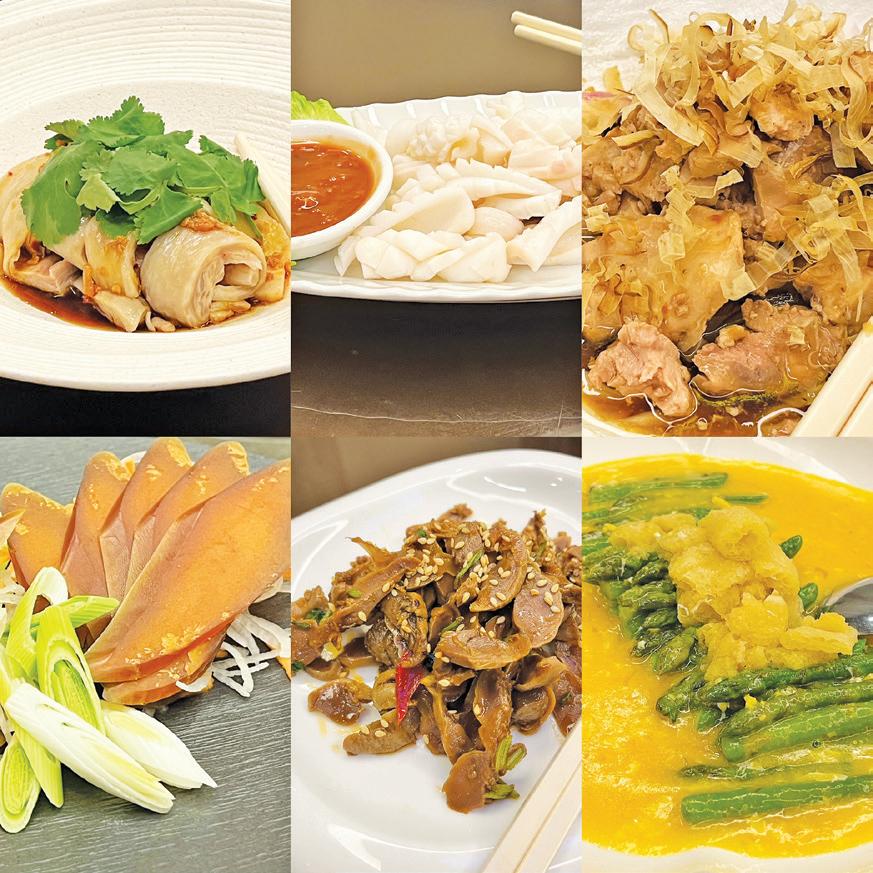
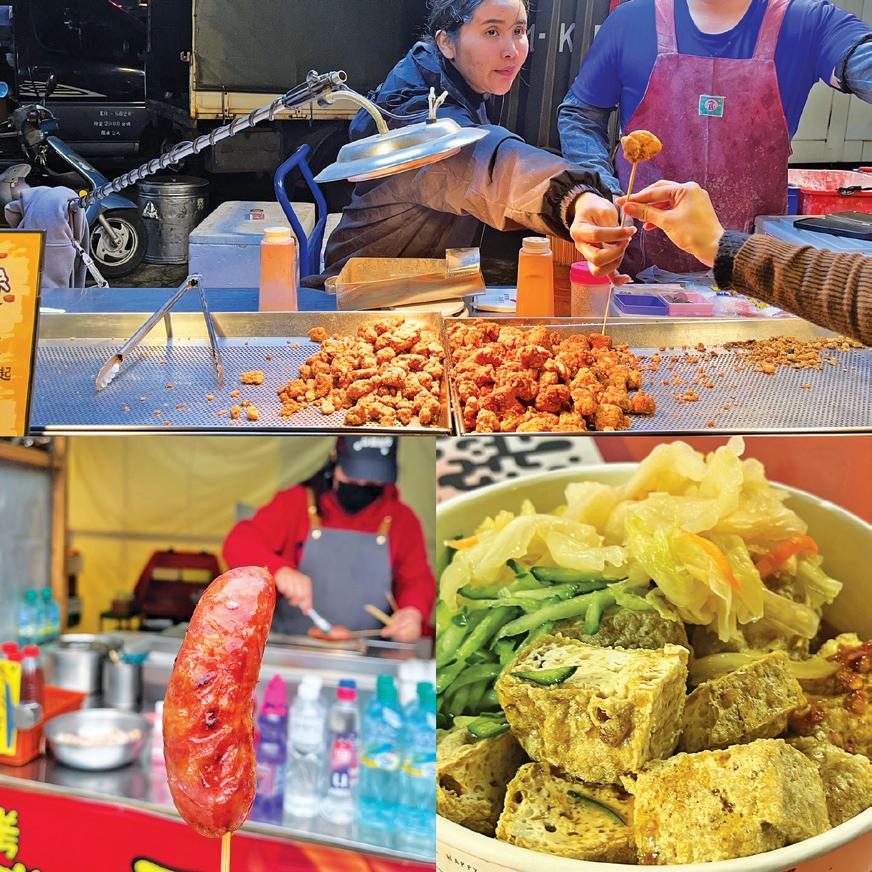
Noodle obsession
What’s a trip to Taiwan without slurping on some noodles? During the trip, I only ate steamed rice once—the heavenly “lu rou fan” or the Taiwanese braised pork rice— the rest were noodles of various kinds.
The first beef noodle soup I tried resembled Sinigang na Baka without the souring agent. The flavor of thick-cut radishes blended into the soup. The round flour noodles were chewy, creating a balance for the super soft beef chunks.
On our trip to the mountains, we stopped by a noodle shop crowded by locals during lunchtime. We had “ban tiao” or Hakka flat rice noodles. The soup was dark with an orange line on the bowl’s rim due to the beef’s fat. What I like most


about it are the simple toppings— cilantro and pickled cabbages— that add a different flavor.
That night, we ate at a hotpot restaurant that also served ban tiao. We all shared the Yunnan Spicy Hotpot, Yunnan Seafood Hotpot and Seafood Kimchi Hotpot. It was straightforward— numbingly spicy soup with chewy noodles. The meal was even special with side dishes such as crispy tofu topped with kimchi, moon shrimp cake and hot fried purple rice mochi sprinkled with powdered sugar. I even left with a takeout as the owner gave me their signature chili oil when I only asked what kind of chili they used for it. Xie Xie!
Another Hakka dish I tried was dry noodles topped with minced braised pork and sweet fried shallots. At this point, I was question-
ing if I could still go on with just eating noodles. That night, we ate beef noodle soup again for the last time.
Street food
Lastly, did you even go to Taiwan if you did not eat any street food? We went to a nearby night market to try various street foods. The smell of stinky tofu and anything that can be braised lingers right when we step foot.
We gave in and ordered the notorious stinky tofu for the experience. Warning: what you smell is what it tastes like. The fermented tofu was fried til crispy and drenched in sweet and salty sauce. The pickled cabbage and sliced cucumber toppings help in cleansing the palate.
Meanwhile, the vendors in the
Taiwanese chicken popcorn stand were giving out a piece to everyone so of course, we grabbed one to taste. And boy, that was flavorful. It’s more on the sweet side compared to the usual five-spice flavor.
Taiwan started the global craze of boba milk tea so of course, we capped the night with one. Most of the milk teas I tried are less sweet since some shops do not have a customizable sweetness level in their drinks. For me, it’s better since you can taste the deep flavor of the tea better.
The other street food I tried that are worth mentioning is the Taiwanese sausage—sweet, fatty, sweet, a little garlicky and something you’ll crave—and the braised rice dumpling and vegetarian spam topped with powder seasonings, sweet and salty sauce and cilantro.
‘Be open to experience’
American chef and traveler Anthony Bourdain said: “Be open to experience, be willing to try new things, don’t have a rigid plan, accept random acts of hospitality without judgment or fear, don’t be afraid to wander, don’t be afraid to eat a bad meal, if you don’t risk the bad meal you never get the magical one.”
Taiwan is the first international destination I’ve traveled to. I was warmly welcomed by the kindest people and the most comforting meals. During the short trip, I ingrained in my mind to be open to anything. We’ve traveled to many places in Taiwan but my favorite memory is discovering small local food spots.
I ditched the breakfast buffet to find where locals eat in an unfamiliar nearby neighborhood. I found one in front of an elementary school. I sat down on a stool and happily munched on an egg pancake filled with pork floss and deep-fried kaya cheese toast, and sipped my warm milk tea. I capped the night in bed with a cold local beer and spicy Taiwanese chicken popcorn from a nearby stall. Anthony’s words ring true. Being open to experience isn’t just about trying new food—it’s about embracing the journey, one bite at a time. And in Taiwan, every bite told a story worth savoring.
N its 84th Anniversary, Philippine Airlines (PAL) celebrates its legacy of bringing the best of the Philippines to the world through its specially curated dessert selection.
Available until May 31, 2025 in select destinations, the new culinary creations highlight how food has the power to evoke nostalgia, transcend borders, and tell stories of heritage and shared experiences.
The special 84th anniversary desserts include the “Trio BiteSized Dessert Plate” consisting of the Classic Leche Flan Topped With Cantaloupe Syrup, Candied Orange, and Coconut Cream; Southern Chocolate Ganache Cake Slice; and Pacencia With Mango Butter Cream Filling.
Filipino Classics With a Twist
A staple in Filipino celebrations, the leche flan is the local version of crème caramel and is often compared to crème brûlée. It is made with egg yolks, milk, sugar, and vanilla extract. For PAL’s anniversary offering, the leche flan is made even creamier and is given a twist: slowsimmered cantaloupe syrup, white chocolate topping, and crushed mango layered beneath.
The Southern Chocolate Ganache Cake Slice is a velvety smooth serving of a decadent dessert made with luscious chocolate from premium cacao beans grown and sourced from
in Davao, and the Pacencia With Mango Butter Cream Filling consists of Filipino meringue cookies and filled with the country’s worldrenowned sweetest mangoes.
The Trio Bite-Sized Dessert Plate will be available to business class passengers in North American destinations that include Los
Angeles, San Francisco, Seattle, and New York. They can also opt for a halo-halo, another classic Filipino dessert that is a refreshing mix of sweetened fruits, various toppings, and milk, or have it served with a cheese platter or an ice cream.
Passengers flying business class in the Honolulu and Austra -

lia destinations, meanwhile, can enjoy the Southern Chocolate Ganache Cake Slice , a cheese platter, or an ice cream.
Fulfilling a Legacy of ‘Care that Comes from the Heart’
Every dessert has been meticulously created to embody PAL’s commit-
ment to providing excellent service, as embodied in its “Care that comes from the heart” promise. This unwavering dedication is a legacy it continues to uphold with pride. With these desserts, PAL is not only providing treats to passengers who have contributed to its continued success for 84 years; they also

showcase how Filipino flavors can create global connections and more memorable journeys. To book a business class flight, visit www.philippineairlines.com or download the Philippine Airlines app. Follow its official social media accounts to stay updated on PAL’s latest promos, events, and flights.


By Philip Paraan Contributor
CHEF Jose Antonio Miguel “Jam” Melchor is one of this generation’s most active champions of the Philippines’ rich gastronomic heritage and has dedicated much of his time and effort on various initiatives concerning the preservation and promotion of Filipino dishes. To further advance his culinary advocacy, he recently launched “Kayumanggi: A Kaleidoscope of Filipino Flavors and Food
A project which is near and dear to him, this cookbook showcases 150 timeless recipes from Luzon, Visayas, and Mindanao and offers an in-depth exploration of its unique flavors, regional origins, and traditional cooking techniques.
The chef and author recalled that over time, he realized he had already compiled a surfeit collection of heirloom recipes, dishes that he had carefully gathered through research and travel, and perfected over the years. He


even brought many of thse recipes with him to official missions abroad where he proudly represented and showcased Philippine cuisine on the global stage.
Plans of publishing this cookbook project began with a proposal to ABS-CBN’s Food Magazine but was put on hold because of production constraints. It being shelved and postponed however turned out positively as it gave rise to a much greater cause, the founding of the Philippine Culinary Heritage Movement, a mission-driven organization to champion and
preserve our country’s rich food culture.
Cultural significance
CHEF Jam, who is also the founder of the Philippine Culinary Heritage Movement, said that “Kayumanggi” aims to highlight the cultural significance of Filipino food, foster appreciation for its historical roots, and inspire a deeper understanding of the diverse influences that have shaped the nation’s culinary identity. Additionally, this local gastronomic resource is to serve as a guide for future gen -
erations, ensuring that the beauty of Filipino cuisine is cherished and remains alive.
The Philippines’ culinary culture is deeply intertwined with national identity, making it essential to pass down traditions to future generations. Through the book, the roots and inspirations behind these dishes are revealed, encouraging readers to explore, celebrate, and appreciate the food that has shaped the nation.
Prominent food historian Felice Sta, Maria, in her foreword of the recipe book said, “Chef Jam has gathered and tested a representation of what identifies the archipelago’s cuisine as Filipino today. This book can be seen as his love poems to the Motherland. Every recipe holds an embrace of affirmation to the past and gift of generosity for the future.’”
True ambassador
US Ambassador MaryKay Carlson who was also present during the book launch thanked Chef Jam for his tireless efforts in promoting Filipino cuisine and described him as a “true ambassador for the Philippines to diners around the world.”
was nurtured early on in his grandmother’s kitchen, where he was inspired by culinary icons like Nora Daza. In 2011, Chef Jam opened Villa Café, offering mod-
ernized Kapampangan heirloom recipes. Immediately in the following year, he launched Bite Contemporary Cuisine, known for its organic dishes and sustainability advocacy. In 2013, he established Healthy Eats Manila, now known as YesPlate, a sustainable diet delivery service in Metro Manila. As the founder of the Philippine Culinary Heritage Movement, Chef Jam played a crucial role in the declaration of April as Filipino Food Month, a national celebration of the country’s culinary traditions. Likewise, he is also an active member of Slow Food International and was the first Filipino chef to present at the University of Gastronomic Sciences in Pollenzo, Italy. Slow food
BEYOND his culinary ventures and entrepre-
Consider
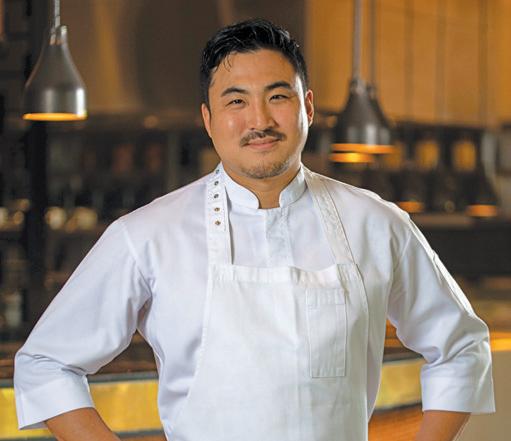

By Francine Medina
THE saying that the proof of the pudding is in the eating can’t be truer than relishing the dishes created by a Michelin-starred chef. To celebrate its 12th anniversary, Solaire Resort Entertainment City treated guests to rare culinary experiences by bringing three of the world’s top chefs for three weeks of ultimate dining iwndulgences. During the weekends of February 28 to March 16, 2025, Solaire presented Michelin-starred chefs who cooked their respective signature dishes. Presenting Michelin-starred chefs during the property’s yearly celebration is getting to be a much-awaited gourmet event. According to Sebastian Kellerhoff, Vice President for Culinary: “For the past three years, we’ve had the privilege of bringing the world’s best chefs
to celebrate our anniversary. Beyond offering exceptional service and unparalleled dining experiences, we also prioritize convenience by bringing Michelin-starred chefs closer to our guests. This allows the Filipino audience to witness firsthand how these culinary masters craft their menus and share their unique flavors, influenced by diverse cultural inspirations,”
Curious epicureans who went to taste the stellar dishes and got a close look at how the chefs deep-dive into their work were not disappointed.
Heritage cuisine FIRST to wow guests was Chef Jun Yukimura, owner of Tokyo’s three-Michelin-starred Azabu Yukimura. Chef Yukimura brought his mastery of Japan’s Kyoto heritage cuisine to Yakumi. Chef Yukimura’s nine-course Kaiseki dinner menu presented the simplicity of fresh, seasonal in-

gredients while also pushing the boundaries of tradition by adding an unfamiliar ingredient to the dishes. For instance, his Hokkaido uni with Ise lobster jelly, cold soba noodles with bottarga powder and the Wagyu shabu-shabu with sansho pepper flower were the epitome of his culinary philosophy.
At Waterside the following weekend, Chef Sun Kim of the two-Michelin star restaurant Meta in Singapore, presented sublime dishes that focused on the freshness of the ingredients and refined taste profile. His six-course tasting menu consisted of signature dishes such as his neatly presented and flavorful Sashimi of tuna with cuttlefish, seaweed, yuzu, and myuga and the very tender Miyazaki grilled Wagyu beef, celtuce, onion puree, and mushroom ragout.
Finestra likewise welcomed Chef Heinz Beck, whose La Pergola in Rome has earned

a three-Michelin star. The restaurant with a stunning view of St. Peter’s Basilica, is known for serving the finest Mediterranean cuisine. His six-course dinner included Red prawn sedanini pasta with smoked aubergine coulis and croutons, and pumpkin risotto, and Pistachio-crusted veal with dried fruits.
Gourmet passport
CONSIDER the yearly presentation of Solaire as a gourmet passport where one doesn’t have to leave home to have that Michelin star experience. The gastronomical treat kicked off when Solaire turned 10 in 2023. Definitely, a grand way to celebrate the end of the pandemic, it was the first time such a feat was achieved: to have five of the world’s greatest chefs from across the continents to cook in the Philippines.
The rock-star chefs who slayed Solaire’s


restaurants were: 12 Michelin-starred Chef Enrico Bartolini of Italy; Chef Tohru Nakamura of two Michelin-starred Geisel’s Werneckhof in Munich, Germany; two Michelin-starred Alvin Leung of Bo Innovation in Hong Kong; one Michelin-starred Rui Silvestre of Vistas Rui Silvestre in Portugal; and pastry chef René Frank of two Michelin-starred dessert restaurant CODA in Berlin, Germany.
Last year, to celebrate Solaire’s 11th anniversary, guests were treated to the prized cuisines of Chef Cristina Bowerman, Chef Patron of Glass Hostaria, a one Michelin-starred restaurant in Rome, Italy; .Chef Goh Fukuyama of one Michelin-starred establishment La Maison de la Nature, with a Michelin Star. in Fukuoka, Japan; and Chef Xu Fan, of the Michelin-starred Xujia Cuisine in Chengdu, China. So, who are next when Solaire celebrates
“Chinese cuisine is all about balance—flavors, textures, and the respect for ingredients. Every dish I create is a reflection of my passion for this culture and the memories I’ve built along the way. This buffet is a true celebration of what Chinese cuisine has to offer.” said Chef Steven. Chef Robert “Bam” Guevarra, Executive Sous Chef of B Hotel Alabang and providing culinary assistance to The Bellevue Manila, specializes in the finest Filipino-Western dishes like Callos con Chorizo and Crispy Beef Ribs. With over two decades of culinary experience, Chef Bam elevates classic flavors with modern twists, offering a unique gastronomic delight that feels both luxurious and comforting.
and
and
Chef Bam said, “For me, food is about comfort and connection. I’m excited to bring together the best Filipino-Western dishes and share the flavors that remind us of home. It’s about creating an experience that goes beyond just eating—it’s about celebrating our roots.”
Chef Yoshi Otsuka of
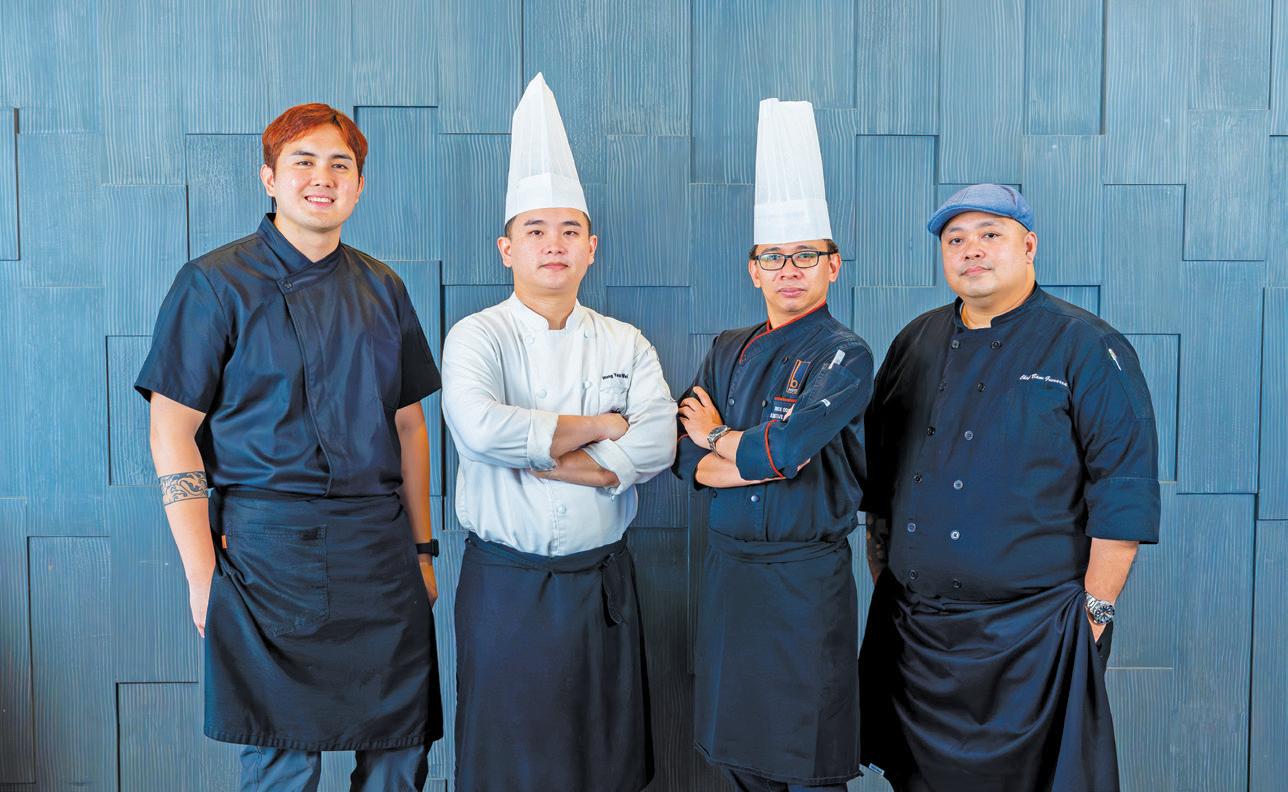
the
and
Chef Steven has built a career rooted in the rich heritage of Chinese culinary traditions, blending technical skills with creativity and passion.
Chef Vince uttered, “Continental cuisine dishes hold a special place in my heart because of their rich history and depth of flavor. For this buffet, I want our guests to experience the beauty of simplicity, great ingredients, and the love that goes into every dish.”
Every Friday to Sunday evening, guests can indulge in a diverse range of flavors, from Chinese delicacies and Filipino-Western fusion to Japanese masterpieces and classic Western and Continental dishes. It’s an exceptional opportunity to enjoy an unforgettable dining experience, all in one place.
“We are thrilled to collaborate with Qsina to bring together such a talented group of chefs to The Bellevue Manila,” says The Bellevue Manila Operations Manager Sonny Ramiro. “The Best of Bellevue buffet is all about offering our guests a truly elevated experience that highlights the diversity of flavors and techniques that our chefs have mastered over the years.”
What makes Best of Bellevue truly special is the heart and passion that each chef pours into their craft. For these chefs, it’s not just about creating exceptional food—it’s about sharing stories, celebrating heritage, and creating lasting memories with those they serve. As each dish is prepared, it’s an invitation for guests to experience the love, dedication, and years of
By Brian King Ong

finest prefectures from Hokkaido to Okinawa. Each omakase and kaiseki journey is a personalized adventure, tailored to your preferences and highlighting the finest flavors of the season. With extensive experience in Japan, Switzerland, and Hong Kong, Chef Ikuma Sato is a master of Edomae-style sushi. His precision and expertise allow him to highlight the natural umami of the freshest seafood, creating sushi that balances simplicity and sophistication.
A Fest for the Senses
THE evening began with a stunning array of appetizers prepared by Chef Sato, the plate was thoughtfully designed to engage all the senses. The appetizers include snow crab with soy gelee, cucumber, and a delicate Japanese vinegar; salmon tataki with a spe -
cial yolk sauce; uni and shimesaba; tamago; and aged duck breast.
A special touch came from the Shiso flowers (Perilla flowers), or “Hojiso” (穂紫 蘇), used to elevate the dish with extra texture and flavor—a detail that would repeat throughout the evening, adding a layer of sophistication to every bite. As we moved on to the sashimi and sushi courses, each piece was a masterpiece, fresh and exquisitely prepared. The sashimi of the day included Ika (squid), Ebi (shrimp), Aburi Maguro (seared tuna), Maguro Otoro (fatty tuna), and Sake (salmon), each cut showcasing the delicate, pure flavors of the ocean. The highlight of the evening was the nigiri sushi assortment of the day. Other standouts included the chawan mushi (steamed egg custard), kanpyou maki, and



an unforgettable serving of uni (sea urchin) and hotate (scallops).
After the array of sushi dishes, a cup of rich miso soup was served, perfectly complementing and concluding the savory dishes. The meal ended with a refreshing dessert: a scoop of your choice from their specialty ice cream flavors and fresh seasonal fruits, topped with “kuromame” (black soybeans). This traditional dish is made by simmering black soybeans in a sweet syrup and is a staple of Osechi Ryori, the New Year’s feast, symbolizing diligence and good health.
Yamazato Manila
Established in 1962 at Hotel Okura Tokyo, Yamazato is a globally recognized fine dining restaurant specializing in authentic Japanese cuisine. It has since expanded internationally, bringing its tradition of excellence to

cities such as Amsterdam, Shanghai, Macau, Bangkok, Taipei, and Manila. Notably, Yamazato Amsterdam became Europe’s first Michelin-starred Japanese restaurant, setting the standard for refined kaiseki, sushi, and teppanyaki dining worldwide.
In Manila, Yamazato Manila provides a range of dining spaces designed to immerse guests in authentic Japanese fine dining.
Whether you’re seated at the sushi counter, teppanyaki grill, or in one of the private dining rooms, the restaurant’s ambiance is refined and elegant. The main dining area offers a serene space for savoring kaiseki or à la carte dishes, each expertly crafted to highlight the flavors of the season.
The Sushi Counter offers an exclusive, front-row seat to the art of sushi making. With only six seats available, reservations are essential, and guests are encouraged to
book at least one day in advance to experience Chef Sato’s artistry up close. The Sushi Counter is only available from Wednesdays to Sundays for lunch and dinner.
For reservations and inquiries, guests can contact +63917 8189868 or email Yamazato at yamazato.service@hotelokuramanila.com. You may also book your tables online at https://bit. ly/ReserveATable-Yamazato.
Hotel Okura Manila
LOCATED in the vibrant heart of Newport City within Newport World Resorts, Hotel Okura Manila epitomizes Japanese luxury and sophistication. Combining the timeless elegance of Japanese hospitality (omotenashi) with the renowned warmth of Filipino service, the hotel offers a seamless blend of comfort and style.
The hotel’s 190 spacious rooms and suites are designed as serene sanctuaries, where every detail invites relaxation. Notably, the Japanese-inspired rooms feature Hinoki wooden bathtubs, crafted from the finest cypress wood from Nagiso Town in Nagano, known for its soothing aroma and healing properties.
Hotel Okura Manila stands
we replied, “Really?!” To which he immediately responded, “Joke lang.” In just a little short of a year in the Philippines, he has already acclimated to our culture. His jokes, experiences, and witty remarks add an extra layer of enjoyment to the experience at Yamazato. We even challenged him to make a sushi pizza, to which he enthusiastically accepted, explaining how he would create it for us. I look forward to that—maybe on my next visit.
By John Eiron R. Francisco
EL LAGO Restaurante, a Spanish dining destination south of Metro Manila, offers a unique culinary experience along the scenic shores of Taal Lake at Mozzafiato Boat Club in Balete, Batangas. The restaurant takes pride in its commitment to authenticity—both in its management and the carefully crafted dishes it serves.
In an exclusive interview with BusinessMirror, Spanish-born Chef Pablo Lopez Iglesias emphasized that beyond just serving great food, his priority is ensuring guests have a memorable experience.
“When I see people enjoying my food, I feel fulfilled,” he shared, adding that guest satisfaction is more valuable to him than anything else.
To achieve this, Chef Pablo takes a handson approach to ensure that he and his team are always present to maintain a welcoming and comfortable atmosphere for their guests.
“The key is always being attentive to clients, making sure they feel special, and ensuring they have a great experience,” he said.
While El Lago Restaurante offers fine dining, Chef Pablo explained that it differs from traditional fine dining establishments in major cities, which can sometimes feel formal or intimidating, especially for first-time visitors. Instead, El Lago provides an elevated yet relaxed dining experience that allows guests to move around freely and soak in the beautiful surroundings.
“Hospitality is not just about the food; it’s about making people feel welcome,” he emphasized.
As an added experience, guests also have the option to book a boat tour around Taal Lake, the third-largest lake in the Philippines, located within an ancient volcanic caldera. While this service, situated near the restaurant, is not directly operated by El Lago, reservations can be arranged in advance through the Mozzafiato Boat Club which offers a scenic and unique complement to their visit.
‘From empty land to culinary destination’
Although El Lago Restaurante—Spanish for “The Lake Restaurant”—officially opened in August 2024, the idea had been brewing for years.
Chef Pablo recalled that when he first visited the location, it was nothing but an empty piece of land. However, after a road trip and a

boat ride around the area, he saw its potential.
“I thought, ‘Wow, this is nice!’ My instinct told me, ‘Yes, you can create something here,’” he shared. “I could already imagine what I could do in this place—serving delicious food while people enjoy this incredible view.” With Taal Lake stretching before him and the majestic Taal Volcano in the distance, he knew this was a special place—one that offered the perfect setting for an unforgettable dining experience.
Beyond its natural beauty, what truly convinced him was Mozzafiato Development— The Active Group's visionary project in Balete, Batangas. “What The Active Group has done here is amazing. They had a vision of creating a beautiful lakeside community, and they made it happen. When I saw this development, I knew right away—a restaurant like this belonged here,” Chef Pablo said.
“I was tired of the big city—too much noise, too much pollution. Here, it’s clean, and I can focus on my ideas,” he added. Inspired by this vision, he saw an opportunity to bring his culinary artistry to a space where people could dine, relax, and connect with nature.
The tranquil setting of Taal Lake has allowed him to slow down, reflect, and fully embrace his passion for cooking. Unlike the relentless pace of city life, where he was constantly busy with back-to-back service, this environment has given him the space to think more clearly, experiment with new dishes, and

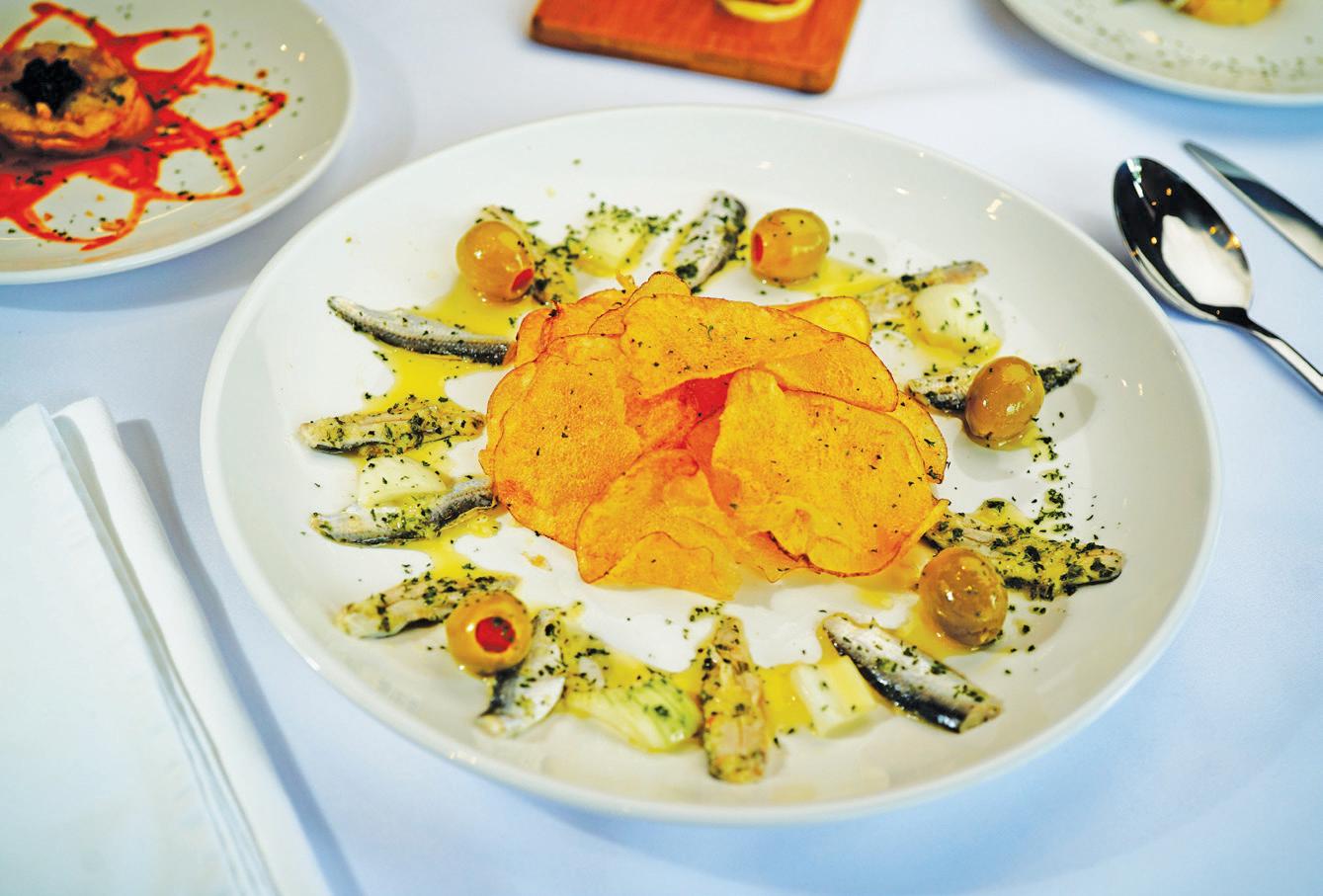
refine his culinary craft.
Commitment to Authentic Flavors
This newfound creative freedom is reflected in his approach to authenticity—a careful balance of tradition and innovation. Rather than simply recreating classic Spanish dishes, he thoughtfully incorporates local ingredients while crafting flavors that feel both familiar and excitingly new.
One standout ingredient he works with is tawilis, the world’s only freshwater sardine, found exclusively in Taal Lake. Chef Pablo is particularly fond of this ingredient, he appreciates both its history and versatility in the kitchen.
“I love tawilis,” he shared. “I know its his-
tory, and I like to take traditional Spanish dishes and mix them with Filipino ingredients. It’s about finding the right balance.”
Beyond tawilis, he sources fresh ingredients from the surrounding area, often incorporating lapu-lapu, a locally caught fish, into his dishes. By applying traditional cooking methods from San Sebastián, he ensures the authenticity of Spanish cuisine while incorporating elements that resonate with Filipino palates. However, maintaining authenticity comes with challenges. Certain ingredients, such as asparagus and mussels, aren’t always available locally. He makes it a point to acquire authentic Spanish ingredients whenever possible. Through his network of suppliers, he can import seafood from Spain and France, with deliver-

ies arriving within 36 hours. This allows him to fulfill special guest requests, such as curating a seafood-centric menu to ensure that every ingredient is fresh and of the highest quality.
Despite his creative reinterpretations of Spanish cuisine, he remains deeply committed to preserving its true flavors. When blending Spanish and Filipino elements—such as in his paella—he insists on executing the dish correctly to maintain its distinctive taste. As he puts it, “everything comes down to the right balance of spices.”
While he enjoys exploring new flavors, his foundation is firmly rooted in traditional Spanish culinary techniques. He values time-tested methods over modern shortcuts, believing that honoring the deep history of Spanish cuisine is what makes his dishes exceptional. This dedication to authenticity is complemented by his extensive experience in fine dining establishments, where he gained a deep understanding of what diners truly appreciate—flavors that are well-balanced, never too overpowering or too subtle. At El Lago Restaurante, this philosophy comes to life through carefully crafted dishes that stay true to the essence of Spanish cuisine while incorporating the depth and richness of Filipino ingredients.
‘Behind the Kitchen doors’ Beyond his mastery of flavors, Chef Pablo’s culinary journey has been shaped by years of experience in Madrid and San Sebastián. It was there that he continuously experimented with different ingredients and techniques which refined his skills and deepened his appreciation for both tradition and innovation. These formative years laid the groundwork for the distinctive ap-
proach he now brings to his kitchen—one that expertly combines authenticity with creativity. However, working in the Philippines presents a different dynamic. The local palate, ingredient availability, and the rhythm of his kitchen all contribute to a unique creative process. Through years of practice, he has developed an instinctive approach, where flavors and techniques naturally come together in a unified blend. Yet, beyond technique, he believes that the heart of any successful kitchen is trust.
“The most important
By Joyce Reyes-Aguila
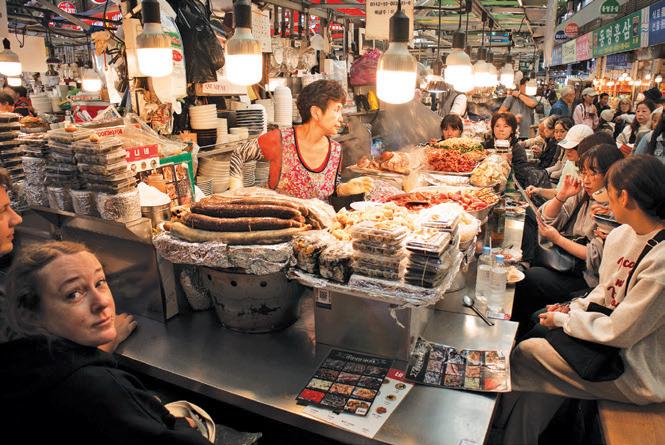

disappoint. Just standing in front of North Gate 2, for example, gives you an idea of what’s in store. A long line welcomes people at this entrance, all leading to the twisted donuts of
abaegi (glutinous rice twist). You will


bored while in queue because the production process for the sweet rice twisted donut, red bean donuts, sweet potato donuts, and black rice donuts is visible to customers as they wait. The donuts are always freshly made and can be eaten on the spot in a small cup or paper bag.
A few steps away from the donuts store is the multi-awarded café Kalas, winner of coffee roasting championships in Korea and in the world since 2015. Aside from the usual cups of latte and espresso, the coffee shop also serves signature drinks such as Monkey Scotch Latte and Kwangjang Latte. Affogato, as well as organic milk or chocolate ice cream, can also be had. While there are no seats at Kalas, a few cocktail tables are available for customers to use, from where you can check out non-stop coffee-pouring action. If that’s not your cup of, well, tea, you can opt to enjoy your drink as your continue to explore the place.
BStory and Photos by Nicole
Paler
ATANGAS is a popular destination for both foreign and local tourists. Within the province, you can find pristine beaches, colorful marine life, diving sites, breathtaking mountain trails and rich heritage. It’s an easy
that are worth discovering, making your visit truly rewarding. PonteFino Hotel, a luxurious 18-hectare estate, is a peaceful retreat paired with modern elegance. Their rooms are bright and cozy, perfect for celebrating life. Their pool is newly renovated, even bigger than before, with plenty of sun loungers and a spacious jacuzzi for relaxation.
Pastorelli THE latest addition to the hotel is an exciting, new restaurant that puts the spotlight on the Filipino-Batangan palette, alongside international culinary delights crafted sustainably with fresh ingredients. “Pastorelli” had their soft launch just this March 19, 2025 with a menu that is spearheaded by Chef Stephen George Bustamante.
“Pastorelli” derived its name from Atty. Antonio Pastor, a scion of a well-known fam -


ily in Batangas City, and the hotel company, PonteFino, which acquired the land for the hotel from his family. In his youth, Pastor enjoyed a vibrant career as a pianist and singer at a famous Italian restaurant in New York, where he got the nickname “Pastorelli” from the Italian restaurant owner. The place was adorned in a bright, cozy ambiance, with a 180-degree view of the pool’s sparkling blue waters and, resonated the feeling of being home for family gatherings and Sunday dinners. During its soft launch, Gabey Abril, Gener-


al Manager for PonteFino Hotel, Chary Francisco, VP for Marketing and Chef Stephen welcomed members of online and print media with a menu that gave the best of what Pastorelli offered: a mix of comforting Filipino tastes with international flavors.
Chef Stephen told BusinessMirror and other media that “Batangueños have a sweeter palette... When you go to Manila, it’s more savory and acid. I’m trying to make that balance (between the two), nothing too sweet but just right so the Batangueños can relate also to what am serving”


Throughout Gwangjang Market, you will see food stalls with halmeonis (grandmothers) and ajumeonis (older ladies) inviting you to sit down and try their meals. Our advice is a to find a one-stop shop that has all the must-haves: tteokboki (simmered rice cake), jajangmyeon (noodles with diced pork, vegetables, and thick black gravy sauce called chunjang), soondae (blood sausage), gimbap (rice rolls with vegetables wrapped in seaweed), bindaettok (mung bean pancake), eumok (fish cakes), and ramyeon (instant noodles). And yes, steamed rice or bap can (and should) be ordered, too. How about a serving of raw beef (yukhoe)? There are a number restaurants which specialize in the dish that seasons ground beef with garlic, soy sauce, sesame oil, and other ingredients. Just a gentle warning: Don’t eat it if you have a weak stomach. You might also want to try some spicy stir-fried octopus (nakjibokkeum). Lots of shops have aquariums where the marine mollusks swim, so you can be sure they’re fresh. But never leave Gwangjang without having a bowl of kalguksu, particularly the one served at Gohyang Kalgaksu. The noodle shop gained popularity after its owner, Cho Yonsoon, was featured in Netflix’s “Street Food Asia” show in 2019. Her inspiring story is truly about hard work, as she got her family out of debt and remained focus on her goals despite receiving mistreatment from some fellow vendors. Have a seat at the counter and enjoy some kalmandu (noodles with dumplings) while you see the stall owner herself at work with two apprentices. You can also order meat or kimchi mandu (dumplings) on the side. And yes, maybe after having your kimchi refilled for free, you can ask Cho Yonsoon for a selfie, despite how busy she is.
The menu
BUT what’s cooking on the menu that will have everyone keep coming back?
For starters, we were served Chef Stephen’s version of Pork Chicharon which is a revelation. Each piece is a play on all your senses. It featured a taste of savory but not too salty perfectly rendered pork fat that gave a musical crackle that assured us it is light, airy, and utterly addictive. I can easily taste this chicharon as a perfect topping to the classic Batangas dish, Lomi.
Soup was then served next and this was the classic Batangas Bulalo. This is the most traditional version of Filipino comfort food you can find, featuring a rich beef broth, tender beef shanks, and the marrow inside the bone. Chef Stephen’s version of the soup was like a warm embrace on a rainy day. The broth, simmered for hours, had a savory depth from the roasted Batangas beef shank and bone marrow, adding complexity to the dish with a gentle sweetness from the corn in the soup. The broth is surprisingly light, I can easily enjoy multiple cups without feeling heavy. It’s a testament to the chef’s skill and the quality of the ingredients.
Chef Stephen also introduced another classic Batangas delicacy, Sinaing na Tulingan, which translates to braised fish. The dish made use of Tulingan or Bullet Fish, braised low and slow with salt, some pork fat, vinegar and kamias until the flesh and bones are tender and infused with subtle tangy flavors.
He presented this classic dish, with the fish wrapped in banana leaves. It honestly took me back to my childhood, evoking memories of my mom making the same dish in her claypot in our backyard kitchen. It was brilliantly balanced and cooked to perfection, as well as created a comforting blend of flavors that for sure transported any Batangueño to simpler times. It’s a reminder of the enduring traditions of Filipino cuisine.

Twist on a Filipino classic
We were served Kare Kare Wagyu next. A luxurious twist on a Filipino classic, this dish showcases Chef Stephen’s innovative approach. While wagyu is usually paired with light tastes, the Kare Kare sauce, rich and creamy, with a depth that comes from hours of simmering somehow also pairs well with this. It gives familiar and a class of elegance in one bite, as the creamy Kare Kare sauce clings to the really tender meat, alongside vegetables like String Beans, Eggplants and Pechay or Chinese Cabbage that added freshness.
You can see and taste Chef Stephen’s mastery of flavor profiles in Pastorelli’s Lamb Adobo. This entree is a gateway of sorts to the Filipino flavor profile for Pastorelli’s international patrons, while giving them a touch of their favored comfort food, and vice-versa. The lamb shank was incredibly tender, stewed in soy sauce, vinegar and garlic among other spices which gave off a feel of comfort in a bite. It was a harmonious blend of traditional flavors and modern techniques that proved even the most familiar dishes can be reimagined.
Chef Stephen’s commitment to using the freshest ingredients shines in the Ginataang Barramundi Fillet. The barramundi had a nice, slightly crispy skin, while the flesh remained tender and flaky. The natural sweetness of the fresh fish takes center stage, complemented by a rich, creamy coconut milk-based “Ginataan” sauce, that left us wanting seconds. Or maybe an extra helping of rice.
Desserts
Complementing these entrees are desserts that feature the Batangas palette prominently, with Pastorelli’s Leche Flan, served to us in a shooter form. Its classic creamy, custardy texture is more decadent than what you would usually find at a restaurant in other parts of

A couple more tips before you head out to Gwangjang Market. Opt to go on weekdays or very early on weekends. Stores open at 9 am all week long. Consider skipping the breakfast buffet at your hotels and come with an empty stomach so you can try (almost) everything you want to. It’s also recommended to include Gwangjang at the early part of your itinerary, in case you want to come back (you will). A majority of the stalls and shops have helpful
the Philippines, and the caramel’s complexity reminded me of the Leche Flans one would find in a town Fiesta in Batangas, served in a Llanera or a leche flan mold. The Biko Cheese Fritters on the other hand showcased Chef Stephen’s creativity. The Biko, or Sinukmani is a traditional Filipino rice cake. Chef Stephen served it wrapped in lumpia wrapper and inside the Biko is a touch of cheese, that created a bombshell of sweet and savory flavors. It was placed atop some home-made Latik or caramelized coconut cream. It paired perfectly with the Kapeng Barako that I ordered, which bridged Batangas tradition and innovation. The desserts definitely left us with a lasting impression. Some of their other must-tries are their Margherita Pizza, Lasagna with a rich bechamel and mozzarella sauce, Crispy Chicken Sandwich, fresh Lumpiang Sariwa, and Pork Binagoongan served with Pastorelli’s home-made shrimp paste. Chef Stephen brought over 20 years of illustrious culinary experience from the United States to Pastorelli. He is a graduate of the California Culinary Academy (2002) with an Associate of Occupational Studies in Culinary Arts. Before joining PonteFino Hotel in 2024, Chef Bustamante served as Executive Sous Chef for Sentro 1771 (2016-2020) and Corporate Executive Chef for One World Deli (2020-2024). With his passion of giving a comforting experience through his food, Pastorelli and PonteFino Hotel is one of the best places to go in Batangas City and celebrate life, because it feels like coming back home.
Pastorelli is open for breakfast from 6 am to 10 am, lunch from 11:30 am to 2:30 pm, and dinner from 6 pm to 10 pm, and is also available for private functions. For reservations and more information, you may visit www.pontefinohotel.com, or call +639159641026.


Sunday, March 30, 2025
Edited by Jose F. Lacaba
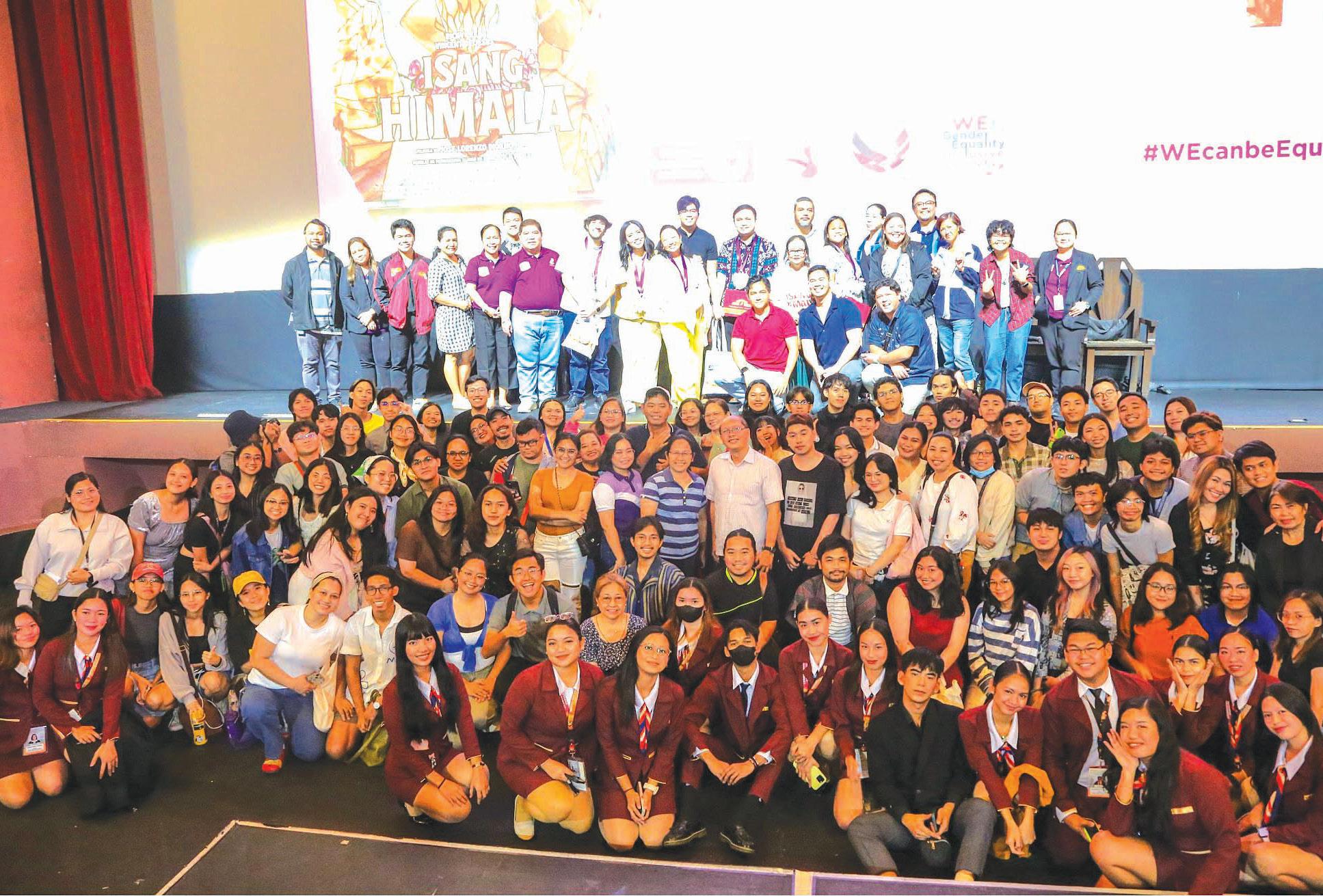
By Seymour B. Sanchez
It was a day of miracles and surprise for the National Commission for Culture and the Arts (NCCA), the Film Development Council of the Philippines (FDCP), the Metropolitan Theater, and the ABS-CBN Film Restoration Project Sagip Pelikula.
Mar. 16,
ng Sineng Filipino, in celebration with National Women’s Month.
BLACK & WHITE
HIMALA, a collaboration among three eventual National Artists—the late director Ishmael Bernal, writer Ricky Lee, and actress Nora Aunor— was shown in the morning at The MET. Considered one of the best Filipino films of all time, viewers saw Himala in its restored black and white version for the first time.
Aunor plays the lead character Elsa, a young woman who grew up in a poor, drought-stricken, and remote provincial town. An apparition from the Virgin Mary soon changes her life and creates a mass hysteria at Barrio Cupang.
The 1982 Bernal masterpiece was produced by the Experimental Cinema of the Philippines, a government-owned corporation, with now Sen. Imee Marcos as its then DirectorGeneral.
Himala was entered in the 1982 Metro Manila Film Festival, winning Best Film, Best Director (Bernal), Best Actress (Aunor), Best Supporting Actor (Spanky Manikan), Best Supporting Actress (Gigi Dueñas), Best Sound Engineering (Rolly Ruta), Best Cinematography (Sergio Lobo), Best Editing (Ike Jarlego, Jr. and Ben Pelayo), and Best Art Direction (Raquel Villavicencio)
It would again win the Best Film award at the 1983 Catholic Mass Media Awards (CMMA) and the Dekada Award for the Ten Best Films of the
Decade from the Manunuri ng PelikulangPilipino
Acclaimed locally, the film gained international awards and recognition—Bronze Hugo Prize at the 1983 Chicago International Film Festival and the Viewer’s Choice Award for the Best Film of All Time in the AsiaPacific Region from the 2008 CNN Asia Pacific Screen Awards.
FROM FILM TO PLAY TO FILM AGAIN
BRINGING theater and cinema together,IsangHimalais a 2024 musical adaptation of the classic Himala. It is a film based on a 2018 theatrical play of the same name, which was in turn adapted from the 1982 film.
Directed by Pepe Diokno and also written by Lee, it triumphantly lent
fresh take on the
TALKBACK SESSION
A TALKBACK session followed the afternoon screening of Isang Himala at the MET. Diokno, the cast, and the film’s supporting ensemble shared their creative journeys and talked about various women’s issues and other relevant concerns relating to the film.
Continued from page 1
Both “Himala” and “Isang Himala” tackled blind faith, false morality, and fake reality—issues, which the Talkback discussants regarded as relevant even today.
Diokno said he first saw the original film as a student and immediately fell in love with it. He watched the musical play in 2018 and 2019 and was equally impressed by it. He eventually became part of Lee’s scriptwriting workshop where he got to know him even better.
Kim Harold Peji of the Philippine Commission on Women joined the talkback session and discussed various programs of the government agency related to the month-long celebration.
Corpuz and NCCA GAD FPS Head Maricel Diaz were present in the
morning and afternoon screenings and awarded certificates of appreciation for the speakers after the talkback session.
BIRTHDAY SURPRISE
2022 National Artist for Film & Broadcast Arts Ricky Lee was the center of tributes at a surprise birthday party held by the event organizers in between the screenings of Himalaand AngHimala Diokno, ABS-CBN Sagip Pelikula Head Leo Katigbak, and NCCA Deputy Executive Director for Operations Bernan Joseph Corpuz delivered their birthday messages for Lee. The staff of the NCCA, FDCP, ABS-CBN Sagip Pelikula, and the cast and crew of Isang Himala also joined the surprise celebration for Lee, who turned 77 last March 19.

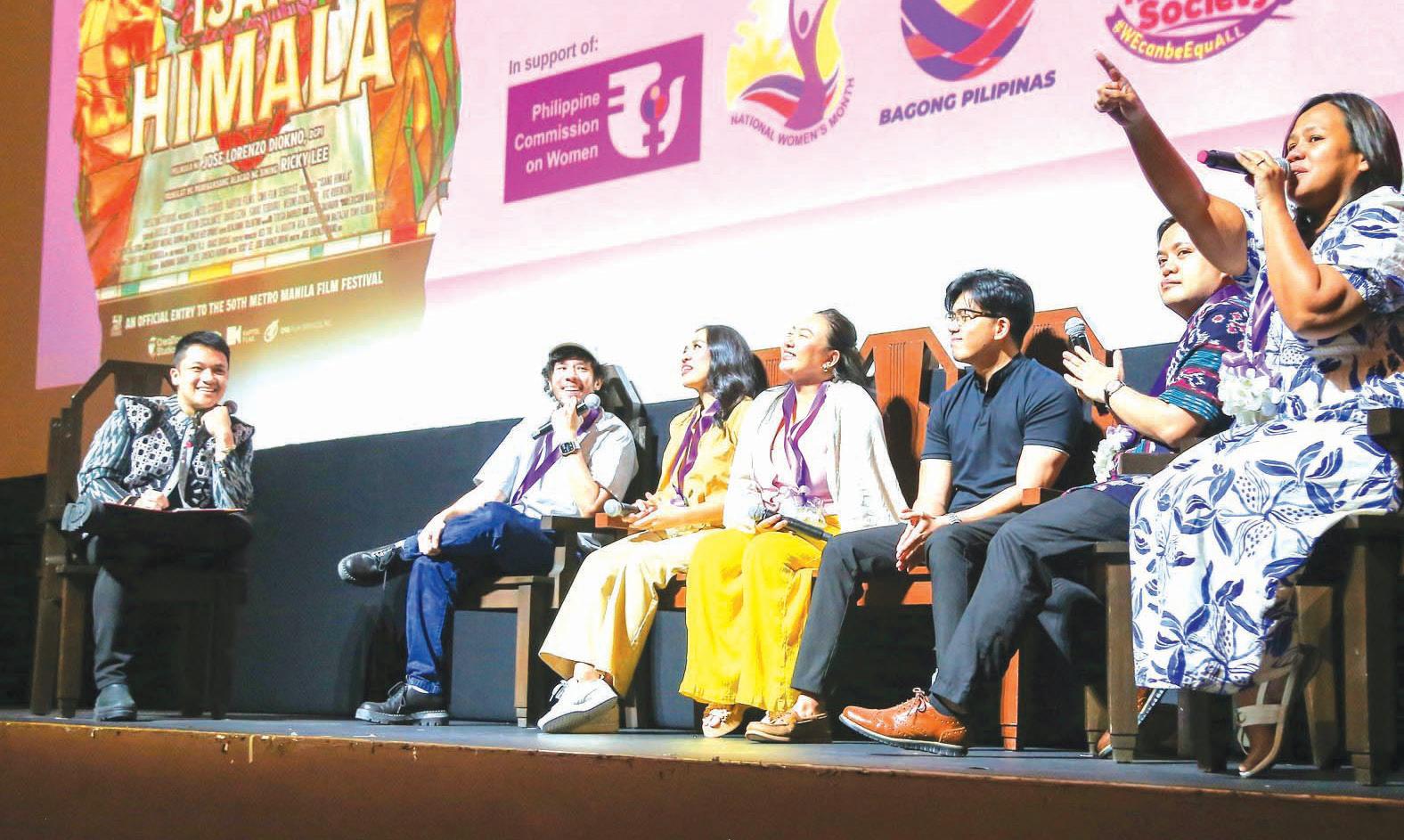
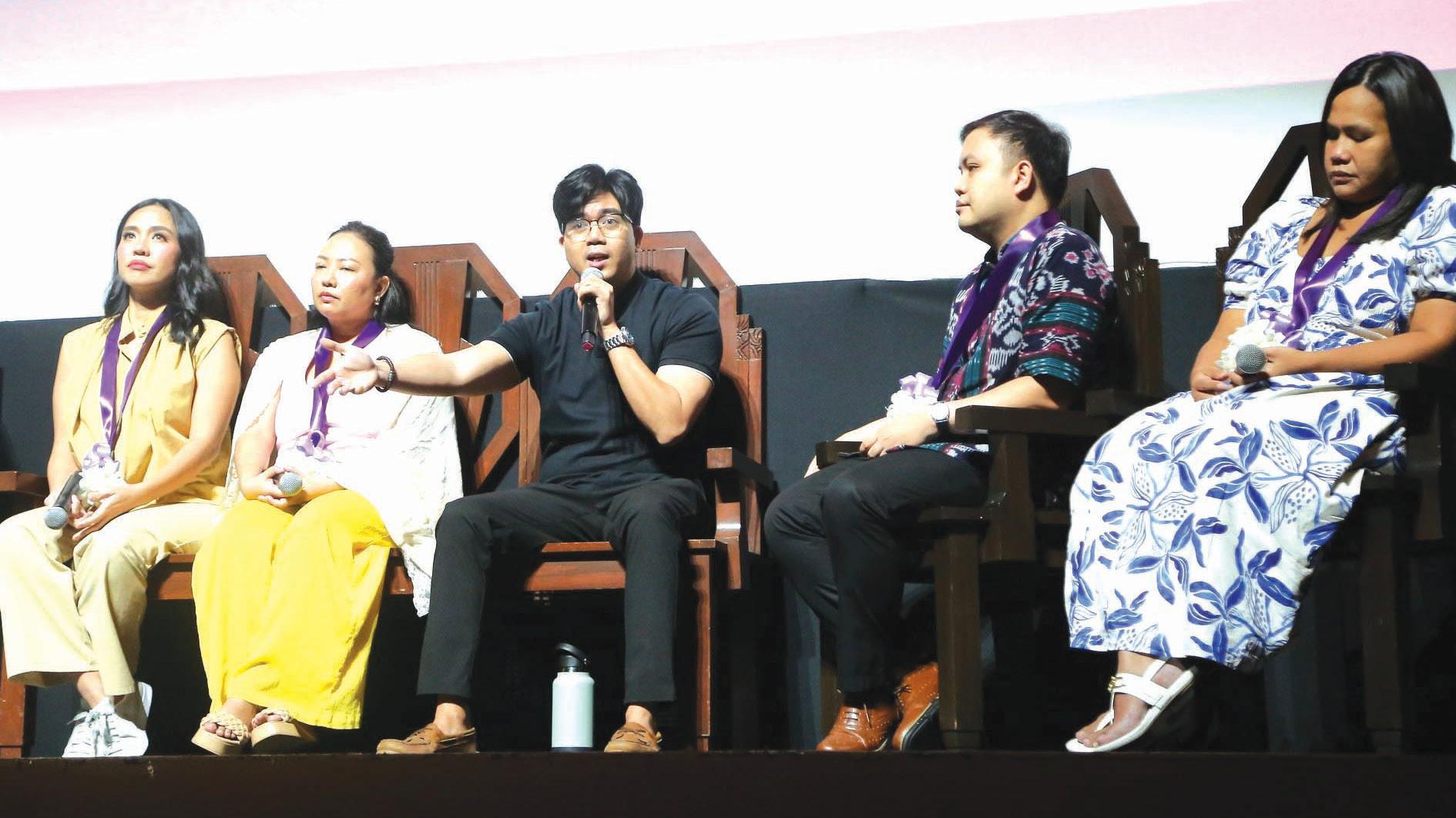





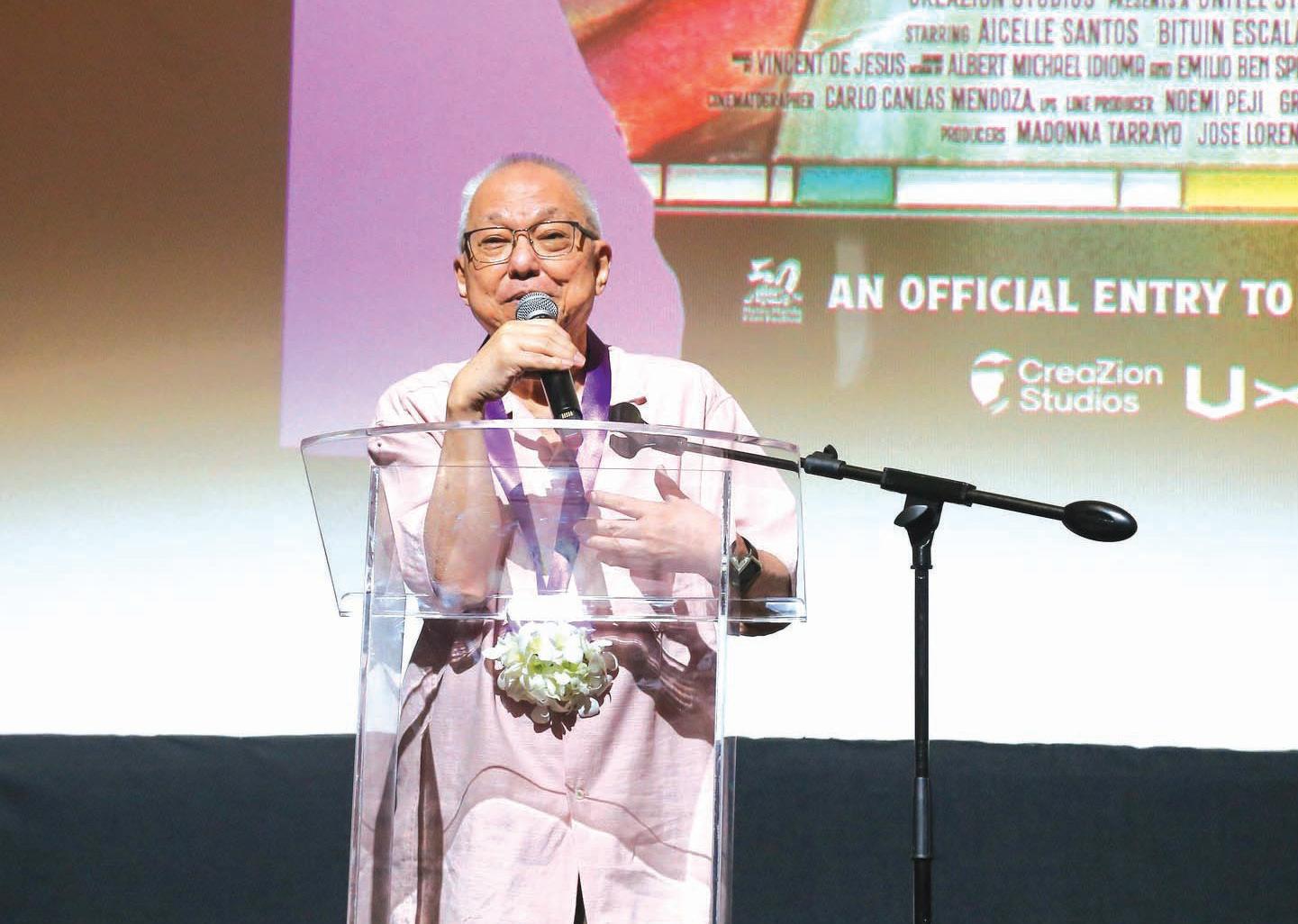







BOLOGNA, ITALY—Following a successful debut participation at the Bologna Children’s Book Fair (BCBF) in 2024, the Philippines is set to return to the world’s foremost event for children’s books, which will take place from March 31 to April 3, 2025, at the BolognaFiere Exhibition Centre in Italy.
The country’s participation will be led by the National Book Development Board (NBDB), with support from the Philippine Board on Books for Young People (PBBY) and the International Board on Books for Young People Philippines (IBBY PH).
Last year marked several milestones for the Philippine book publishing industry.
Before its successful presentation at the Frankfurt Book Fair in October, the Philippines made waves in the book world with its children’s book sector being selected as the Country of Focus at the Asian Festival of Children’s Content in Singapore.
This set the stage for the Philippines’ debut at the BCBF, where the country showcased over 100 children’s books in a dedicated stand.
EXPANDING PARTICIPATION
FOR 2025, the Philippines is poised to build on last year’s success with an even more robust presence.
The delegation will be represented by a talented group of children’s book professionals, including illustrator Fran Alvarez (Dancing Hands: A Story of Friendship in Filipino Sign Language), authors Faye VillanuevaChelabian (co-founder of Kawangis Publishing), Liwliwa Malabed (Sampung Eroplano), Ergoe Tinio (Editor-in-Chief of Center for Art, NewVentures&SustainableDevelop-
ment),and MJ Tumamac (co-founder of Aklat Alamid), alongside Eli Camacho (Product Development Manager at Adarna House), Sophia Garduce (Southern Voices Printing Press), and Isa Songco (co-founder of Kwentoon).
“This is another win for our children’s book sector, which is an enduring and vital part of our book industry.
If our participation at the BCBF last year was an introduction to our children’s books, this year, we’re expanding our participation with a larger book curation focused on themes that represent the true nature of Philippine children’s stories: progressive, endlessly curious, and consider children as smart, imaginative readers with a great sense of agency,” said NBDB Executive Director Charisse Aquino-Tugade.
This year’s curation will feature 120 titles that explore a variety of themes, including Philippine culture, diversity, environmental awareness, and sense of self and community.
This selection of early readers, middle grade, and young adult books features both old and new voices in the Philippine children’s book sector, highlighting the authors and illustrators behind one of the country’s most widely read and translated genres.
ART WORKSHOPS, RECEPTION, HAPPY HOUR
THE Philippines will host a range of
activities, including an art workshop for children, which will take place at the Philippine Embassy in Rome on Mar. 29, from 3 p.m. to 5 p.m.
The event will feature two sessions: Mom’s Best Playdough Activities focusing on Philippine national symbols, and an art workshop by Liza Flores of Ang INK (Ang Ilustrador ng Kabataan), encouraging young participants to explore their creativity while learning about Filipino culture.
On Apr. 1, from 4 p.m. to 6 p.m., the Philippine Collective Stand will host a reception, welcoming Ambassador Nathaniel G. Imperial and Consul General Elmer G. Cato, along with other representatives from the Philippine Embassy in Rome and the Philippine Consulate in Milan.
In addition to these, the Philippines is supporting a special Happy Hour event called Drink & Draw with the Philippines, organized by German Stories and the Frankfurter Buchmesse. This gathering will take place on Apr. 1 at 5 p.m. in Hall 30, B24-C11.
1,500 EXHIBITORS
SINCE 1964, the Bologna Children’s Book Fair has been the industryleading fair where professionals working in children’s content from all over the world meet for networking, rights selling, and other opportunities for cross-media adaptation, as well as expand their knowledge in the art of creating children’s books through fora, workshops, exhibits, talks, and other activities. Over 25,000 visitors attend the BCBF every year.
This year, the BCBF will feature 1,500 exhibitors from approximately 90 countries and regions around the world.
The Philippine country stand will be located at Hall 29, B24-C23. For industry professionals looking to attend the Bologna Children’s Book Fair, tickets can be purchased at https:// www.bolognachildrensbookfair.com/ en/visitors/ticket-online/1131.html



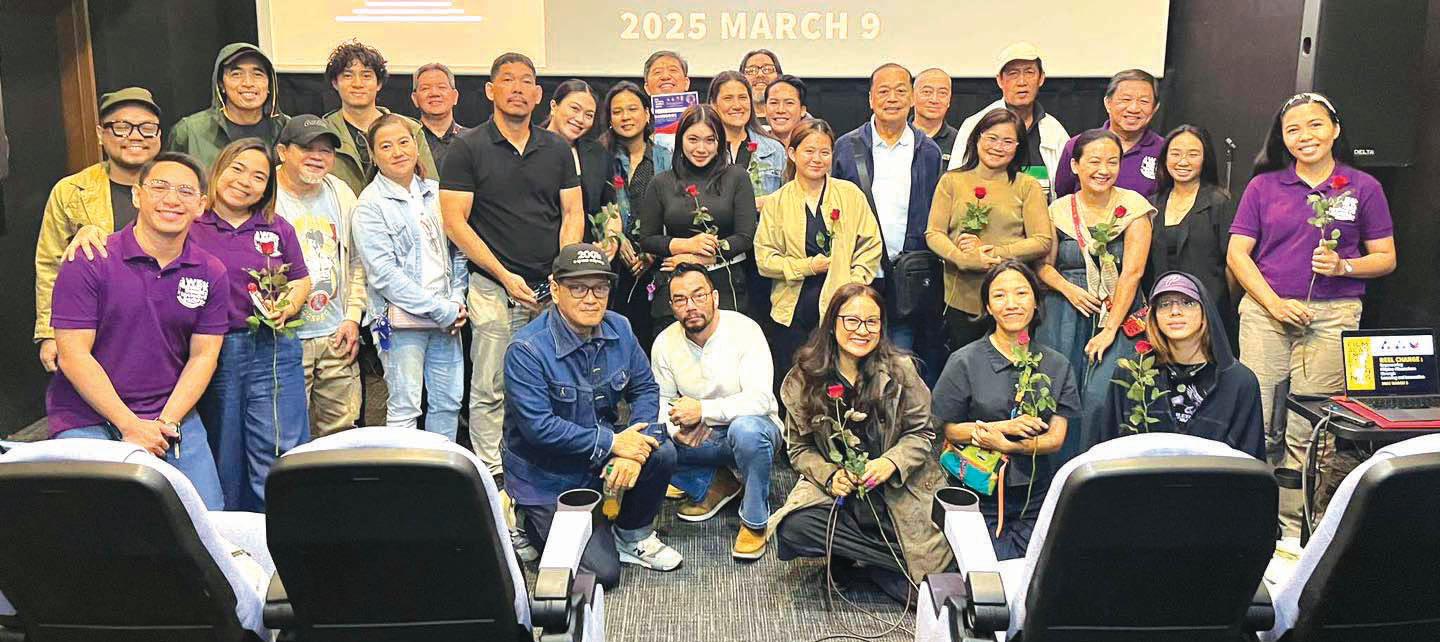
WITH the vision of initiating behavioral change among entertainment industry workers, the Film Academy of the Philippines (FAP) conducted a learning session and workshop last Mar. 9.
Held in partnership with the Department of Labor and Employment Bureau of Working Conditions (DOLE-BWC), the seminar-workshop was held at the Dencar Theater, MOWELFUND in Quezon City, in celebration of the 2025 National Women’s Month.
Highlights of the event included discussions on gender-based violence-related laws, a short film screening and talkback session, and a workshop on intimacy scenes—all geared toward promoting safer spaces in the entertainment sector.
CHANGING MINDSETS
“ THE fight against gender-based sexual harassment is not just about compliance. It is about changing mindsets and fostering a work environment where every individual—regardless of gender, position, or background must feel safe, heard, and valued,” DOLE-BWC Director Atty. Alvin B. Curada said.
Curada was the first speaker of the FAP program that had for its theme—“REEL CHANGE: Empowering Filipino Filmmakers through Learning and Innovation.”
The DOLE-BWC Director stressed the need “to ensure safe, inclusive, and
dignified work environments across all industries.”
DOLE-BWC Medical Officer Dr. Marco Antonio Valeros focused on the discussion of Republic Act No. 7877 (Anti-Sexual Harassment Act) and Republic Act No. 11313 or the Safe Spaces Act.
Valeros underscored the importance of stronger protections against Gender-Based Sexual Harassment (GBSH) in the workplace. He gave an in-depth discussion on “GBSH Safe Spaces Act: Promoting Safe Workspaces” and its relevance to the film and television industry.
Overall, the discussions emphasized the shared responsibility of employers and workers in creating a harassment-free environment. It touched on “the continued coordinated efforts to promote anti-harassment policies, empower Committees on Decorum and Investigation (CODI), and intensify industry-wide awareness campaigns to create safer and more respectful workplaces.”
Hosted by Actress-filmmaker Sheenly Gener, respected denizens in the field of entertainment attended the FAP-DOLE event. These included—FAP Director General Paolo Vil-
laluna, former FAP OIC and veteran production designer Manny Morfe, Director’s Guild of the Philippines, Inc. President Mark Meily, producers Janel Gutierrez and Kristine Kintana, Katipunan ng mga Artista ng Pelikulang Pilipino at Telebisyon (KAPPT) President Hero Bautista, Philippine Talent Guilds President and Founder Evangeline Torcino, and filmmakers Raymond Red, Pam Miras, Jules Katanyag, Dustin Celestino, Ma-an Asuncion-Dagñalan, Michael Angelo Dagñalan, Paul Sta. Ana, Seymour Sanchez, Max Celada, and Celeste Lapida.
WORKPLACE EXPERIENCES
A SCREENING of the award-winning short film CrossMyHeartand Hope to Die and a talkback session with director Sam Manacsa and producer Chad Cabigon gave participants an opportunity to reflect on workplace experiences and reallife scenarios.
Dr. Missy Maramara, certified intimacy director and coordinator of the Intimacy Directors and Coordinators, Inc. and the Intimacy Professionals Association, tackled the rules on set protocols when shooting sensitive scenes. She supervised workshop exercises like “Bawas Tao sa Set.”
Participants viewed her discussion on set protocols as highly relevant in ensuring safety and professionalism during intimate or challenging film productions.
FAP and DOLE-BWC aim to hold the event on a bigger scale to reaffirm its commitment to strengthen labor rights and enhance occupational safety and health standards. Seymour B. Sanchez

